

Space Tourism: How Much Does it Cost & Who's Offering It?
Last Updated: December 17, 2022
Many of us dream of going to space and over 600 people have traveled to space as astronauts in government-funded agencies such as NASA, the European Space Agency, and Roscosmos. But how much does spaceflight cost in today and how is that expected to change in the coming years?
With new advancements in spaceflight technology, the costs of space travel are decreasing, making the dream of spaceflight a little closer for us all.
Evolution of Spaceflight Costs and Technologies
During the space race, the cost of sending something into space averaged between $6,000 to over $25,000 per kg of weight not adjusted for inflation and NASA spent $28 billion to land astronauts on the moon, about $288 billion in today’s dollars.
In recent decades, it has averaged around $10,000 per kg though certain missions have been higher due to other factors including the destination, the size of the rocket, the amount of fuel needed, and the cost of fuel.
After the retirement of the space shuttle program, NASA paid Russia to transport astronauts to the ISS at about $80 million per seat on the Soyuz rocket. NASA’s biggest and newest rocket, the SLS (Space Launch System) which is currently being utilized for the new moon missions including Artemis and Orion, currently costs about $2-4 billion per launch.
But recent years and the addition of private space companies have drastically changed the game. NASA allowed private space companies to develop equipment for missions, including a 2006 partnership with SpaceX under the Commercial Orbital Transportation Services (COTS) program to provide resupply for crew and cargo demonstration contracts to the International Space Station (ISS).
This partnership has continued to flourish over the years with SpaceX successfully launching two NASA astronauts in May 2020 on a Crew Dragon Spacecraft, making SpaceX the first private company to send astronauts to the ISS and the first crewed orbital launch from American soil in 9 years.
With the revolutionary technology of reusable boosters from SpaceX, the cost has plummeted, achieving less than $1,600 per kg with the Falcon Heavy (still totaling more than $100 million per launch) and even a projected cost of under a thousand for their next generation model Star Ship.
These recent innovations are even making SLS the more expensive, less efficient option if SpaceX’s projections continue to progress as expected within margins of error. We shall see how NASA plans to adapt goals in light of this.
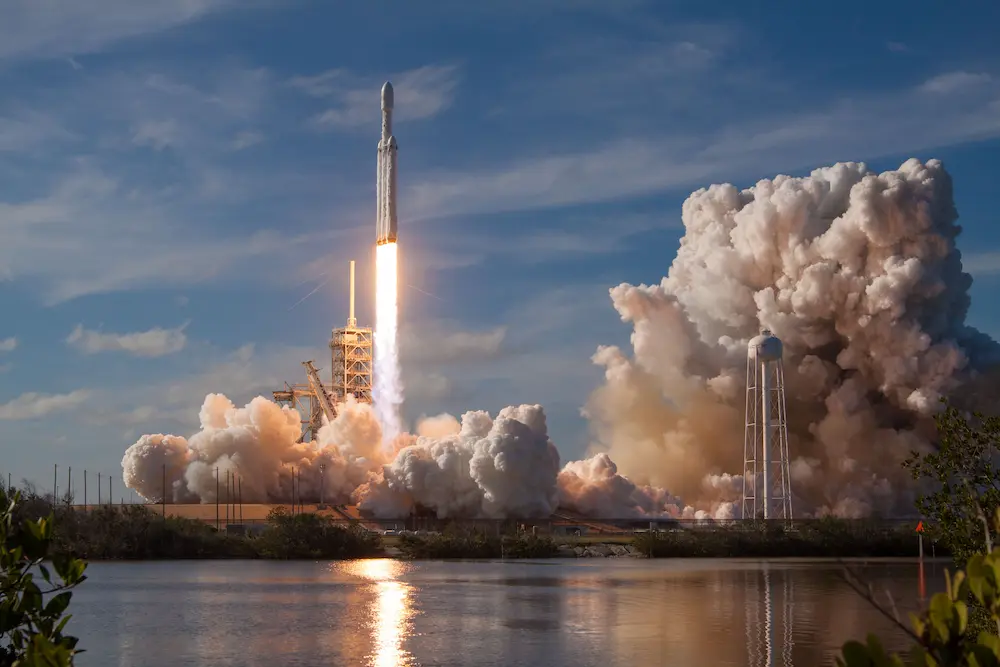
The Falcon Heavy is a cost-effective option for launching payloads into space.
The rise of private space companies
With private space companies, the opportunity for civilians to book a trip to space similar to booking a flight came closer to reality. Dennis Tito was the first private citizen to pay for a trip to space with a trip to the ISS from April 28th to May 6th, 2001 for $20 million dollars. Tito purchased his experience through Space Adventures Inc. which was founded in 1998 and offers a variety of different space experiences. They even acquired Zero Gravity Corporation, NASA’s provider of Reduced Gravity Training (not in space) for its astronauts, in 2008. They offer similar experiences for private individuals starting at about $8,200 as of this publishing (December 2022).
Space Adventures sent seven other space tourists to the ISS through 2009, but due to a number of factors, Space Adventures had to put their ISS offerings on hold until 2021 when they were able to purchase two Soyuz seats due to NASA moving their contract to SpaceX. Space Adventures sent two people to the ISS via the Roscosmos Soyuz rocket in December 2021 and is working on expanding its offerings.
In addition to Elon Musk’s SpaceX, there are a number of other private space companies getting into the commercial spaceflight/ space tourism market, most notably Richard Branson’s Virgin Galactic and Jeff Bezos’s Blue Origins.
Flight Providers & Rates
What are the current rates for commercial spaceflight tickets? What commercial spaceflight trips have already happened? All prices are per person/ per seat.
SpaceX has had the most experience in sending humans to space thanks to its partnership with NASA and Musk has made it clear that he wants to make space travel an option for the public. To date, SpaceX has offered two commercial spaceflight options and has one big one planned for the future:
- SpaceX completed a Multi-Day Orbital Voyage, the first of their new plan to offer private astronaut experiences through their NASA partnership.
- Estimated $55 million for a 3-day stay inside a modified SpaceX Dragon capsule orbiting the Earth at 357 miles (574 km) with three crewmates, sponsored by billionaire Jared Isaacman to raise money for St Jude’s Children’s Hospital
- Partnership between SpaceX and Houston-based Axiom Space Inc.
- $55 million for a 10-day trip to ISS at 408 km with a weeklong (8-day) stay in the orbital lab.
- Expected to continue in 2023
- Axiom plans to build a stand-alone space station to replace the ISS with the first module expected to launch in 2024.
- Steve Aoki: American DJ and record producer
- Everyday Astronaut Tim Dodd: American science communicator, content creator, photographer, and musician
- Yemi A.D.: Czech choreographer, art director and performer
- Rhiannon Adam: Irish photographer
- Karim Iliya: British photographer and filmmaker
- Brendan Hall: American filmmaker and photographer
- Dev Joshi: Indian television actor
- Choi Seung-hyun (stage name: T.O.P.): South Korean rapper, singer, songwriter, record producer, and actor
- Cost is unknown, likely a minimum of $500 million
2. Blue Origin
Blue Origin: currently offers a 100km 12-minute ride to the Karman Line, the recognized boundary between Earth’s atmosphere and outer space; pricing is still unclear and dependent on a variety of factors
- On July 2021, Jeff and Mark Bezos went into space on the New Shepard rocket with Oliver Daemen (who won the trip through an auction bid of around 28 million) and honored guest Wally Funk (a member of Mercury 13, the private program in which women trained to be astronauts but ultimately never went to space)
- Blue Origin has completed 6 commercial space flights as of this publishing. Some “honorable guests” have been invited free of charge, such as Funk and actor William Shatner (Captain Kirk from the original Star Trek). Some have been sponsored or have received special deals due to their nonprofit status.
- $28 million winning auction bid for the first flight ( $19 million was donated)
- $1 million for a board member of a nonprofit
- About $1.25 for a Dude Perfect comedy group crew member, hosted by MoonDAO in August 2022
3. Virgin Galactic Subortbital Joy Ride
Virgin Galactic Subortbital Joy Ride: $450,000 for a 90-minute ride to suborbital space 50km above sea level
- In July 2021, founder Richard Branson flew to the edge of Earth’s atmosphere with two pilots and three other Virgin Galactic employees as the first test of commercial spaceflight for the company
- Each VSS Unity SpaceShipTwo carries up to four passengers
- Expected flights are currently anticipated to begin in 2023
- Includes training accommodations and amenities; launches from New Mexico
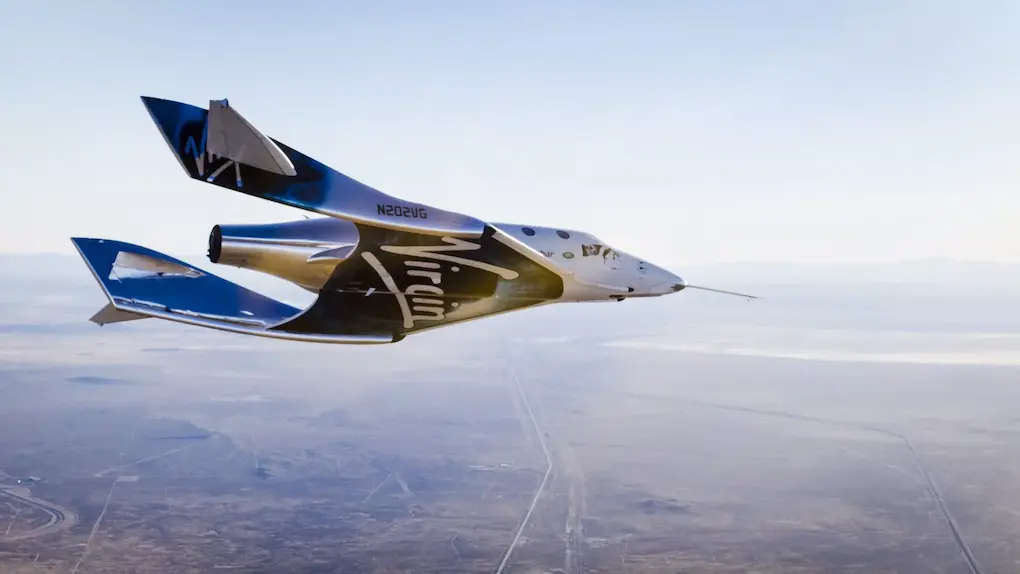
4. Roscosmos/ Space Adventures Customized ISS Trip
Roscosmos/ Space Adventures Customized ISS Trip: $50-60million for a 12-day trip to the ISS at 408 km
- In October 2021 an actress and director shot scenes for the first movie filmed in space
- December 2021 Japanese billionaire Yusaku Maezawa and Yozo Hirano for two days (same billionaire planning to go to the moon with SpaceX)
- With the current situation between Russia and Ukraine, this option is effectively nonexistent currently
5. Space Perspective
Space Perspective: a six-hour balloon ride to space/ the stratosphere on their “Spaceship Neptune” at $125,000
- Rides are currently scheduled to begin by the end of 2024.
- A pressurized capsule will be slowly lifted by a football-field-sized hydrogen-filled balloon 19 miles (30 km) into the stratosphere, about 3 times the altitude of commercial planes.
- The passenger cabin features a bar, bathroom, and windows for sightseeing and is expected to carry 8 passengers and 1 pilot per trip.
6. Aurora Space Station (no longer in development)
Aurora Space Station was supposed to be the world’s first luxury space hotel, offering a 12-day stay for $9.5 million allowing them to free float, observe space and earth, practice hydroponics and play in a hologram deck, but they shut down operations and refunded all deposits in March 2021. They received a lot of media attention and therefore are noted here due to that notoriety.
Conclusion: the current cost of flying to space
Currently, it is only available to those who can spend an average of $250,000 to $500,000 for suborbital trips (about a fifteen-minute ride to the edge of space and back) or flights to actual orbit at more than $50 million per seat (though typically a longer trip than 15 minutes).
It could be free/ discounted if you can find a sponsor, often for nonprofit/ charity purposes, or if you are someone of notoriety that can help spread the company’s mission.
Waitlists are available for most offerings, with a deposit, with many stretching years into the future, which might end up helping you have a spot at a more reasonable price in the future if you can save up.
Many companies are looking to provide extended stay options on private space stations in the future, similar to how you might book a flight somewhere and stay in a hotel for a few days. Again, for the immediate future, this is estimated to cost tens of millions of dollars. The biggest portion of the cost would be launching them, though it is still estimated that a couple million dollars will be needed to cover the expenses of your stay while you are on the space station, whether that is included in the ticket price or added on top of that.
Many companies are hopeful they can eventually price a trip to space down to $100,000 but that will likely take some time, even with the cost-saving measures of reusable boosters. Many forms of recent technology have evolved exponentially in recent years and with dropping price rates as well. Just as plane travel was originally prohibitively expensive, but has now become fairly reasonable for the average consumer, the hope is that the same will eventually happen with space tourism, but we will have to see how long that takes.
While the possibility of going to space is still out of reach for many of us, hopefully, the advancements in recent years and those yet to come will help to continually lower the costs of going to space, just as has occurred in many other fields. This author, for one, truly hopes that the interest of the elite who are currently able to participate in these offerings will spur research and development, not just of space tourism but space exploration in general, to help fuel a quicker journey to space access for all

Written by Sarah Hoffschwelle
Sarah Hoffschwelle is a freelance writer who covers a combination of topics including astronomy, general science and STEM, self-development, art, and societal commentary. In the past, Sarah worked in educational nonprofits providing free-choice learning experiences for audiences ages 2-99. As a lifelong space nerd, she loves sharing the universe with others through her words. She currently writes on Medium at https://medium.com/@sarah-marie and authors self-help and children’s books.
Wow! There's more to read 🚀
This page is part of our collection of articles about astronauts . If you enjoyed the read, then you’ll love the following articles.

How much do astronauts get paid?
The requirements to become an astronaut are extremely rigorous. Does their salary match the difficulty of their profession?
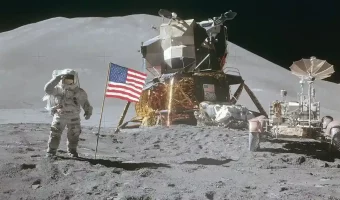
How many flags are on the Moon? The up-to-date list
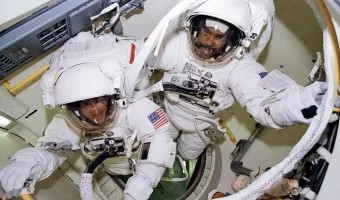
What are the different types of astronauts suit?
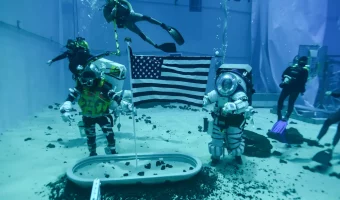
How do astronauts train for zero-gravity environments?
What will space tourists get when they fly with SpaceX, Blue Origin, and Virgin Galactic? Spacesuits, sleeping bags ... and Jeff Bezos
- Virgin Galactic's $250,000 ticket to the edge of space includes a spacesuit.
- Passengers paying $55 million for SpaceX's mission to the ISS get sleeping bags, hygiene products.
- Blue Origin's $28 million spaceflight comes with a seat next to Jeff Bezos.
- See more stories on Insider's business page .

The era of space tourism has dawned.
Richard Branson is scheduled to blast off in Virgin Galactic's VSS Unity on Sunday for the company's first fully-crewed rocket-powered test flight .
If the launch goes ahead as planned, he'll be 9 days ahead of Amazon founder Jeff Bezos, who plans to travel to the edge of space on July 20 in Blue Origin's New Shepard spacecraft.
Meanwhile, SpaceX's private mission with Axiom Space is scheduled to fly four passengers to the International Space Station (ISS) in early 2022.
Read more: As Jeff Bezos and Richard Branson blast off, here are 11 of the most exciting space startups according to VCs
The journeys certainly aren't cheap. Trips aboard Virgin Galactic's VSS Unity will cost passengers $250,000 apiece. A seat on Blue Origin's New Shepard craft was auctioned off at $28 million in June. And the four passengers traveling to the ISS on SpaceX's Crew Dragon will pay a cool $55 million a head.
The question is, what bang will they get for their buck?
SpaceX and Axiom
A ticket for Axiom's mission to the ISS will include:
- Mission planning
- Life support
- Medical support
- Crew provisions
- Eight days aboard the ISS
Staying on the ISS costs the astronauts about $6.8 million a day, NASA told The Verge in January.
Related stories
According to NASA's 2021 price list , it should cost $2,000 per crew member per day for food and drinks aboard the ISS. It'll also cost each person as much as $1,500 per day for things like clothing, hygiene products, office supplies, and sleeping bags.
Blue Origin
The unnamed winner of Blue Origin's auction will accompany Jeff Bezos and his brother on an 11-minute trip on the New Shepard craft. For their $28 million they will be getting:
- On-site accommodation
Blue Origin hasn't yet disclosed commercial seat prices for flights on New Shepard.
Before stepping aboard, passengers must show they can deal with heights, walk on uneven surfaces, and support up to three times their weight, Insider previously reported.
"There are a couple days of training in advance of the flight," a Blue Origin spokesperson told Insider in June. "Some of the training includes learning procedures for getting into and out of the capsule, a mission simulation, and learning techniques for how to move around in zero-g."
Virgin Galactic
Around 600 customers across 58 countries have already forked out up to $250,000 for a seat on Virgin Galactic's Unity spacecraft, which will take them to the edge of space.
A spokesperson from Virgin Galactic told Insider that the ticket includes:
- A spacesuit
Unlike Blue Origin's New Shepard rocket, Unity won't pass the Kármán line, an imaginary boundary between the atmosphere and space. When Virgin Galactic's Unity reaches this height, passengers will experience several minutes of weightlessness before the spacecraft returns to Earth.
Branson, 70, has gone through months of training in preparation for his flight, which is scheduled for July 11.
Watch: How SpaceX, Blue Origin, and Virgin Galactic plan on taking you to space
- Main content
We have completed maintenance on Astronomy.com and action may be required on your account. Learn More

- Login/Register
- Solar System
- Exotic Objects
- Upcoming Events
- Deep-Sky Objects
- Observing Basics
- Telescopes and Equipment
- Astrophotography
- Space Exploration
- Human Spaceflight
- Robotic Spaceflight
- The Magazine
Six ways to buy a ticket to space in 2021
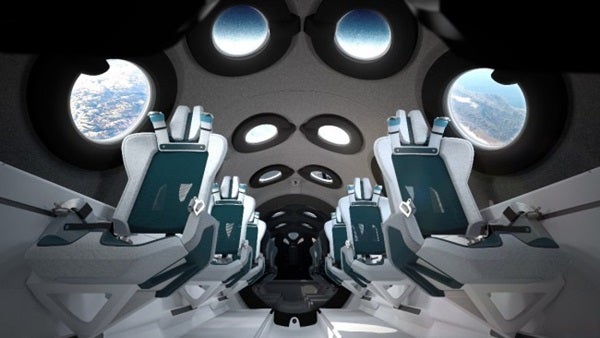
Earlier this month, SpaceX’s Crew Dragon capsule safely ferried NASA astronauts Doug Hurley and Robert Behnken back to Earth following a multi-month trip to the International Space Station (ISS). No privately built spacecraft had ever carried humans into orbit before. But unlike SpaceShipOne, which was a single craft built specifically to win a prize, there are multiple models of the Crew Dragon, each designed to be reused.
It’s finally looking like the exciting era of space tourism is about to erupt. A handful of so-called “new space” companies are now competing to sell space tourists trips on private spacecraft. Each one has a slightly different means of reaching space, and not all of them will get you all the way into orbit. But as long as you’re rich, you should have no problem purchasing your ticket to space.
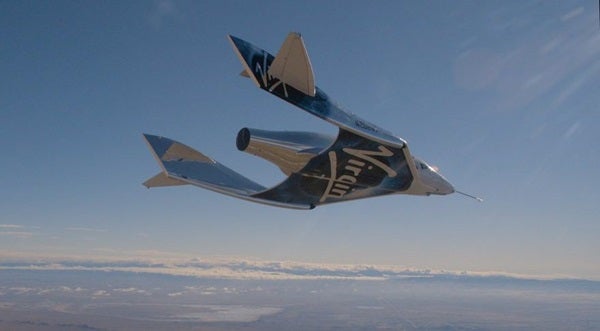
Virgin Galactic
SpaceShipOne was retired after just three successful spaceflights, but the technology lives on in Virgin Galactic’s Spaceship Unity . Like its predecessor, Virgin Galactic’s rocketplane drops from a specially engineered aircraft before boosting itself to 50 miles (80 kilometers) in altitude. That’s high enough for Virgin Galactic’s pilots to earn their astronaut badges. However, others define space via the so-called Kármán line, the generally accepted boundary between Earth’s atmosphere and space that sits 62 miles (100 kilometers) above our planet’s surface.
Virgin Galactic’s goal is to become “the world’s first commercial spaceline,” and eventually they’ll offer regular flights from Spaceport America in southern New Mexico. The company is planning to begin regular flights in early 2021, with CEO Richard Branson slated as the first non-professional pilot to travel on Spaceship Unity .
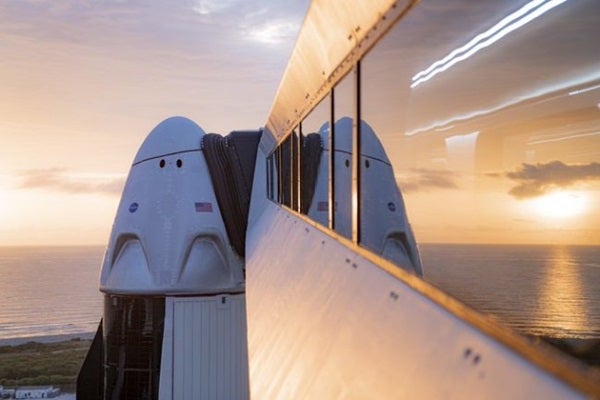
SpaceX is the only private rocket company to ever send a human into orbit. They’re also the only company now NASA-certified to send people to circle Earth. So, when will SpaceX start selling tickets to private citizens for trips to space? In the past, Elon Musk has said that the spacecraft could have a bright future carrying private passengers into orbit. And SpaceX recently announced that it has already sold seats on future Crew Dragon flights through other companies that are handling the logistics.
Ultimately though, Musk’s goal is to settle Mars. And to do that, he needs a bigger spacecraft. That’s why SpaceX’s engineers are working feverishly on its Starship, which is still under development. If the enormous spaceship works, it could literally rocket dozens of space tourists at a time between a number of destinations on Earth, or perhaps throughout the inner solar system. The company says that Starship would be able to travel between any two locations on Earth in less than one hour.
SpaceX is confident enough in their vessel that they already sold a Starship flight around the Moon to Japanese billionaire Yusaku Maezawa. No human has traveled to the Moon in nearly 50 years, and Maezawa, a fashion designer and online clothing retailer, has said he’ll take a group of artists with him.
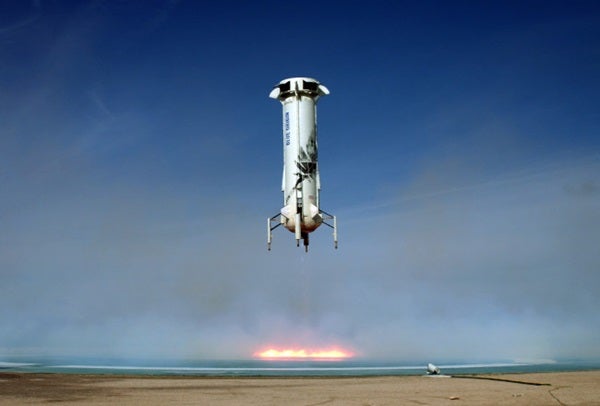
Blue Origin
Jeff Bezos started his rocket company, Blue Origin, back in 2000. And he’s been selling Amazon stock to pump billions of dollars into the effort ever since. Like SpaceX, they’re prioritizing reusable rockets and spacecraft that can drastically reduce the cost associated with spaceflight.
Much of Blue Origin’s effort has gone into developing a pair of rockets: New Shepard and New Glenn.
New Shepard can carry six people inside a suborbital capsule some 60 miles (100 km) into space. Blue Origin has already flown a dozen test flights, and they’re still planning several additional tests before launching passengers. However, in March, Axios reported that Blue Origin could send passengers into space in 2020, though COVID-19 has caused delays across the space industry. If the company can still get its space capsule tested in 2020, it could be on course for paid flights in 2021.
Meanwhile, Blue Origin has announced that it will soon start selling tickets. The company’s website doesn’t list the price of a Blue Origin trip, but Bezos has previously said their space tourists can expect to pay hundreds of thousands of dollars to fly in its New Shepard capsule.
The company is also working hard on their New Glenn rocket, a heavy-lift, reusable launch vehicle that Blue Origin has already invested more than $2.5 billion into developing. It’s larger than SpaceX’s Falcon Heavy rocket, but smaller than the rocket planned with Starship. That size could eventually enable regular passenger trips into orbit and even beyond. The company will need that capacity, too. Blue Origin’s goal is to one day have millions of people living and working in space.
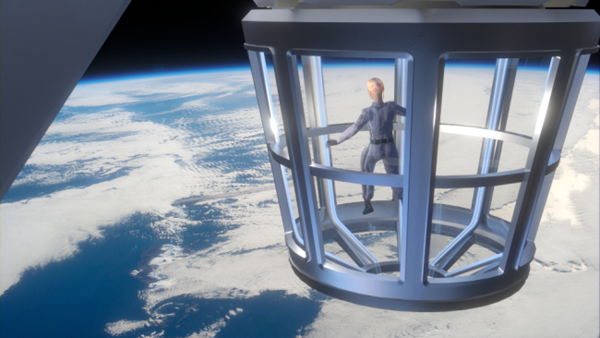
Axiom Space’s goal is to create the world’s first commercial space station. In the meantime, they’ve inked a deal to send a crew of private citizens to the ISS aboard SpaceX’s Crew Dragon capsule in October 2021.
Axiom’s initial crewed mission, dubbed Ax1, should send three paying astronauts to the ISS. Each ticket reportedly costs $55 million. And while it might seem like there’s a small pool of potential ticket buyers at that rate, in the U.S. alone, roughly 75,000 American households have that much money. Axiom also figures it’s just getting started selling tickets to space. In the near future, the company says it will send three crews a year to the ISS.
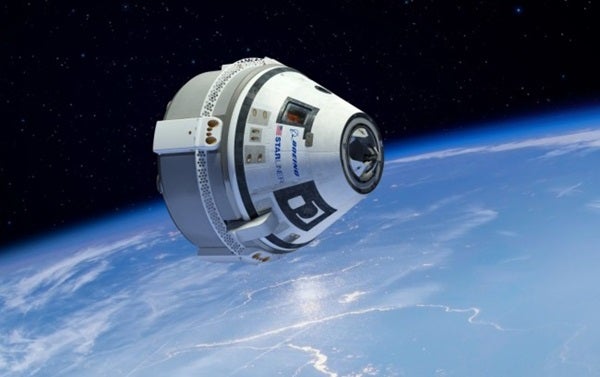
Back in 2014, NASA selected two companies — SpaceX and Boeing — to receive multibillion-dollar contracts to build spacecraft that could ferry astronauts to the ISS. SpaceX made good on the first crewed flight of its Commercial Crew Program contract earlier this year. Meanwhile, Boeing has yet to get its Starliner spacecraft safely to the ISS and back. Their first test flight reached orbit but failed to make the space station, and a NASA review outlined numerous necessary fixes.
Boeing will attempt another uncrewed test flight next year. And if all goes well, they could fly to the ISS by late 2021.
But once Boeing is flying to and from the ISS, the iconic aerospace company is also technically allowed to fly private passengers to the space station. They’ve been quiet on this option, but NASA has said they’d accommodate passengers at a rate of $35,000 per night.
Boeing has also hired a corporate test pilot astronaut, Christopher Ferguson. He’s been training alongside NASA’s astronauts and will be among the first to fly on Starliner. He might not count as a space tourist, but Ferguson will ultimately be part of an entirely new group of professional astronauts that work for private companies, not national space agencies.
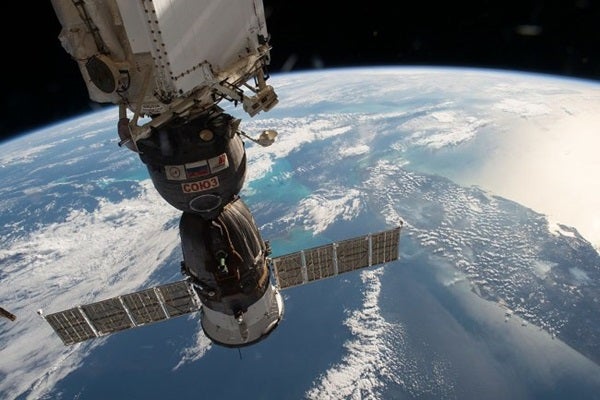
Space Adventures
Space Adventures is an American company that offers private spaceflights to the ISS and, eventually, the moon. Since their founding in 1998, the company has sold a number of other spaceflight related experiences, like simulated zero-gravity airplane flights. And unlike their competitors, Space Adventures has sent space tourists into orbit, too. They’ve been responsible for over half a dozen paid trips to the ISS that made use of Russian spacecraft.
Most recently, they booked a launch to the space station on Russia’s veteran Soyuz spacecraft, which is set for December 2021. The mission, dubbed Soyuz MS-20, will fly with a lone cosmonaut and two Space Adventures tourists.
Space Adventures has arranged another path to get paying customers into space, too. They recently announced a deal with SpaceX that will put four space tourists in a SpaceX capsule and send them into orbit around Earth. How much will it cost? For now, both companies are keeping the cost of these tickets private. But those who do make the trip should get an excellent show. The mission will orbit at several times the height of the ISS.
Unfortunately, few of us have enough disposable income to fund a trip beyond Earth’s atmosphere. But with at least a half dozen ways for the wealthy to purchase a ticket into space next year, the hope is that the cost will continue to decline. And if that happens, you might be closer than you think to regularly having your rocket pass checked by the TSA.

Meet Katya Echazarreta, the first Mexican-born woman to travel to space

A metal chunk that burst through a Florida home came from the ISS

The search is on for extraterrestrial life on worlds like Enceladus

The clever prince Ulugh Beg built — and used — an ingenious observatory in the 15th century

An updated list of space missions: Current and upcoming voyages

The largest digital camera ever made for astronomy is done

NASA seeks faster, cheaper options to return Mars samples to Earth

NASA bids farewell to the Ingenuity Mars Helicopter with new photos

These are the clever messages headed to Jupiter aboard NASA’s Europa Clipper
How much is a seat on Virgin Galactic? $450,000. Here's what each trip includes.

Virgin Galactic will soon sell tickets for space trips to the public. The catch? They cost $450,000.
On Tuesday, the aerospace company announced plans to sell tickets to the general public to snag a seat for a future spaceflight.
Reservations open up Feb. 16 and will cost $450,000. Potential travelers must pay a $150,000 deposit to hold the spot, then pay the rest before their flight. Tickets will be available to 1,000 customers for trips later this year.
The flights will take off from Spaceport America in New Mexico. Virgin Galactic said trips will last about 90 minutes.
"The spaceship gracefully flips while astronauts enjoy several minutes of out-of-seat weightlessness and breath-taking views of Earth from the spaceship’s 17 windows," reads a statement from the company.
BUDGET SMARTPHONES: You can get a good phone without the iPhone price tag
NOT A TYPO: Worldle is like Wordle but with geography puzzles.
Virgin Galactic is among several companies including SpaceX and Blue Origin – run by tech entrepreneurs Elon Musk and Jeff Bezos respectively – pressing forward with plans to eventually support commercial space travel.
On July 11, Virgin Galactic founder Richard Branson was among six crewmembers who traveled aboard the company's space plane, the VSS Unity. Two months later, the Federal Aviation Administration said it was investigating the flight .
Blue Origin launched a manned flight on July 20 with Bezos among the members of the crew. In September, SpaceX launched its first flight with an all-civilian crew.
Follow Brett Molina on Twitter: @brettmolina23 .
How much does space travel cost?
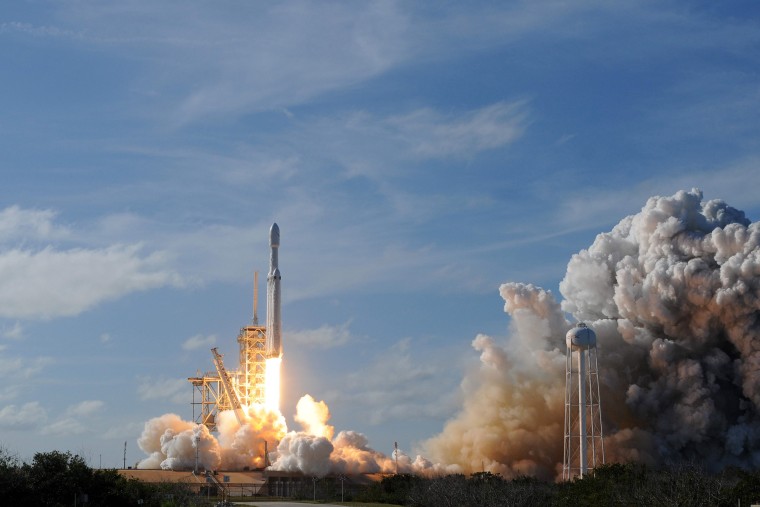
Spaceflight has traditionally been a government-led activity — and it's never been cheap. But the stratospheric cost of putting people and payloads into space is finally starting to fall, thanks in part to the rise of SpaceX and other private spaceflight companies.
Here’s a look at what it costs to go to space, whether it’s another satellite that needs to be placed in orbit or an adventurous billionaire looking for a joyride around the moon .
Sending up a satellite
Using its 230-foot-tall Falcon 9, SpaceX charges $62 million to send into orbit commercial satellites weighing up to 50,000 pounds. The closest American competitor is the United Launch Alliance Atlas V, which starts at $73 million for a 41,000-pound payload .
Science Sign Up for the Daily MACH Newsletter
Those are just starting prices; government agencies typically pay more for a long list of extra services. The Air Force, for example, is paying SpaceX $96.5 million to launch a GPS satellite in 2019 .
Flying to the International Space Station
Since NASA mothballed its space shuttles in 2011, NASA has relied on the Russian Soyuz spacecraft to get astronauts to the ISS. Russia has been steadily raising the price of Soyuz seats, reaching $82 million each in 2015. The agency last purchased Soyuz seats for $75 million apiece in 2017.
NASA hopes to end its reliance on Russia in 2019, when SpaceX's Crew Dragon and Boeing's Starliner capsules begin “taxi” flights to the ISS. Seats on those spacecraft are expected to cost about $58 million .
How much would I have to pay for a flight into space?
Depending on where you're going, a ticket could set you back anywhere from $250,000 to tens of millions of dollars.
If you're looking simply to cross the 62-mile-high Karman line that marks the boundary between the upper atmosphere and outer space, Virgin Galactic says it will take you there for $250,000. The company says about 650 people already have tickets for the suborbital flights, to be made aboard a winged vehicle called SpaceShipTwo. A date for customer flights has yet to be announced.
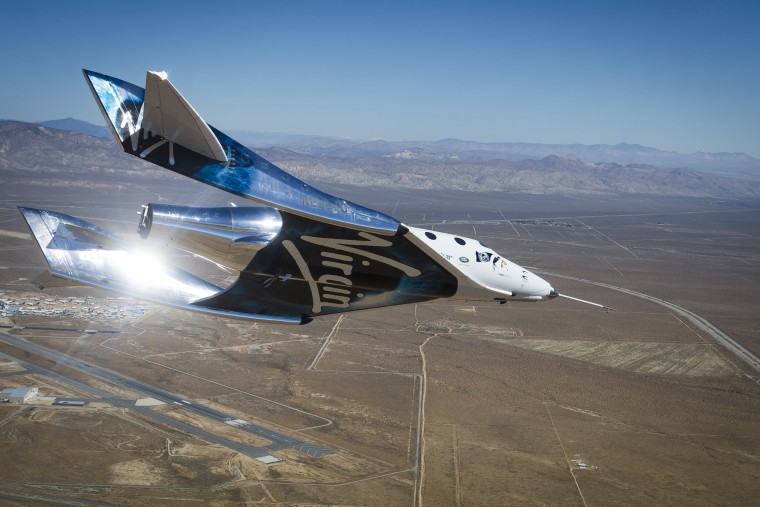
Jeff Bezos’ rocket company, Blue Origin, plans something similar — sending space tourists on brief suborbital flights using its New Shepard rocket system. The company has yet to set ticket prices or say when paid flights might begin.
Virgin Galactic and Blue Origin passengers will join the fewer than a dozen private citizens who have funded their own trips into space. From 2001 to 2009, the Vienna, Virginia-based firm Space Adventures worked with Russia’s space agency to send eight people to the ISS on flights lasting 10 or more days.

Space A colossal elevator to space could be going up sooner than you ever imagined
The world's first private astronaut, a wealthy American engineer named Dennis Tito, reportedly paid $20 million to spend eight days in space in 2001. More recently, Guy Laliberté, the co-founder of Cirque du Soleil, shelled out $35 million for an ISS trip in 2009 . Space Adventures still advertises Soyuz flights and plans to start booking trips to the ISS aboard Boeing’s Starliner.
In September 2018, SpaceX CEO Elon Musk announced that Japanese billionaire Yusaku Maezawa would ride the company’s yet-to-be-built Big Falcon Rocket on a trip around the moon. Neither Musk nor Maezawa, who said he would take along seven artists, would discuss the mission’s cost.
What about other rockets?
Small satellites may qualify for a free ride to space through NASA’s Educational Launch of Nanosatellites program, which helps universities and research groups fly standardized satellites called CubeSats aboard rockets as secondary payloads.
If your satellite can’t hitch a free ride, you can book a NASA sounding rocket to the edge of space for as little as $1 million . For orbital flights of payloads weighing less than 500 pounds, Los Angeles-based Rocket Lab offers launches of its Electron rocket from New Zealand for about $5 million .
From there, the price goes up steeply. Northrop Grumman's Pegasus rocket, which is air-launched from the belly of a jumbo jet, can place 1,000 pounds in orbit for about $40 million . Stratolaunch, a new venture bankrolled by Microsoft co-founder Paul Allen, plans to launch Pegasus rockets from its own colossal airplane before offering an expanded line of rockets capable of carrying up to 13,000 pounds. The company has yet to disclose prices.
NASA is developing its Space Launch System, which will carry astronauts to the moon and Mars. The rocket’s per-launch cost has not been disclosed, but the agency now spends at least $2 billion per year on the project. The maiden flight isn’t expected until 2020.
WANT MORE STORIES ABOUT SPACE TRAVEL?
- NASA solar probe to go where no spacecraft has gone before
- Space shuttle relic to be resurrected as deep-space habitat
- The animals that paved the way for humans in space
FOLLOW NBC NEWS MACH ON TWITTER , FACEBOOK , AND INSTAGRAM .
- Share full article
Advertisement
Supported by
The Future of Space Tourism Is Now. Well, Not Quite.
From zero-pressure balloon trips to astronaut boot camps, reservations for getting off the planet — or pretending to — are skyrocketing. The prices, however, are still out of this world.

By Debra Kamin
Ilida Alvarez has dreamed of traveling to space since she was a child. But Ms. Alvarez, a legal-mediation firm owner, is afraid of flying, and she isn’t a billionaire — two facts that she was sure, until just a few weeks ago, would keep her fantasy as out of reach as the stars. She was wrong.
Ms. Alvarez, 46, and her husband, Rafael Landestoy, recently booked a flight on a 10-person pressurized capsule that — attached to a massive helium-filled balloon — will gently float to 100,000 feet while passengers sip champagne and recline in ergonomic chairs. The reservation required a $500 deposit; the flight itself will cost $50,000 and last six to 12 hours.
“I feel like it was tailor-made for the chickens like me who don’t want to get on a rocket,” said Ms. Alvarez, whose flight, organized by a company called World View , is scheduled to depart from the Grand Canyon in 2024.
Less than a year after Jeff Bezos and Richard Branson kicked off a commercial space race by blasting into the upper atmosphere within weeks of each other last summer, the global space tourism market is skyrocketing, with dozens of companies now offering reservations for everything from zero-pressure balloon trips to astronaut boot camps and simulated zero-gravity flights. But don’t don your spacesuit just yet. While the financial services company UBS estimates the space travel market will be worth $3 billion by 2030, the Federal Aviation Administration has yet to approve most out-of-this-world trips, and construction has not started on the first space hotel. And while access and options — not to mention launchpads — are burgeoning, space tourism remains astronomically expensive for most.
First, what counts as space travel?
Sixty miles (about 100 kilometers) above our heads lies the Kármán line, the widely accepted aeronautical boundary of the earth’s atmosphere. It’s the boundary used by the Féderátion Aéronautique Internationale, which certifies and controls global astronautical records. But many organizations in the United States, including the F.A.A. and NASA, define everything above 50 miles to be space.
Much of the attention has been focused on a trio of billionaire-led rocket companies: Mr. Bezos’ Blue Origin , whose passengers have included William Shatner; Mr. Branson’s Virgin Galactic , where tickets for a suborbital spaceflight start at $450,000; and Elon Musk’s SpaceX , which in September launched an all-civilian spaceflight, with no trained astronauts on board. Mr. Branson’s inaugural Virgin Galactic flight in 2021 reached about 53 miles, while Blue Origin flies above the 62-mile mark. Both are eclipsed by SpaceX, whose rockets charge far deeper in to the cosmos, reaching more than 120 miles above Earth.
Balloons, like those operated by World View, don’t go nearly as high. But even at their maximum altitude of 18 or 19 miles, operators say they float high enough to show travelers the curvature of the planet, and give them a chance to experience the overview effect — an intense perspective shift that many astronauts say kicks in when you view Earth from above.
Now, how to get there …
Blue Origin and Virgin Galactic, which are both licensed for passenger space travel by the F.A.A., are open for ticket sales. (Blue Origin remains mum on pricing.) Both companies currently have hundreds or even thousands of earthlings on their wait lists for a whirl to the edge of space. SpaceX charges tens of millions of dollars for its further-reaching flights and is building a new facility in Texas that is currently under F.A.A. review.
Craig Curran is a major space enthusiast — he’s held a reserved seat on a Virgin Galactic flight since 2011 — and the owner of Deprez Travel in Rochester, N.Y. The travel agency has a special space travel arm, Galactic Experiences by Deprez , through which Mr. Curran sells everything from rocket launch tickets to astronaut training.
Sales in the space tourism space, Mr. Curran acknowledges, “are reasonably difficult to make,” and mostly come from peer-to-peer networking. “You can imagine that people who spend $450,000 to go to space probably operate in circles that are not the same as yours and mine,” he said.
Some of Mr. Curran’s most popular offerings include flights where you can experience the same stomach-dropping feeling of zero gravity that astronauts feel in space, which he arranges for clients via chartered, specialized Boeing 727s that are flown in parabolic arcs to mimic being in space. Operators including Zero G also offer the service; the cost is around $8,200.
You can almost count the number of completed space tourist launches on one hand — Blue Origin has had four; SpaceX, two. Virgin Galactic, meanwhile, on Thursday announced the launch of its commercial passenger service, previously scheduled for late 2022, was delayed until early 2023. Many of those on waiting lists are biding their time before blastoff by signing up for training. Axiom Space, which contracts with SpaceX, currently offers NASA-partnered training at Houston’s Johnson Space Center. Virgin Galactic, which already offers a “customized Future Astronaut Readiness program” at its Spaceport America facility in New Mexico, is also partnering with NASA to build a training program for private astronauts.
Would-be space tourists should not expect the rigor that NASA astronauts face. Training for Virgin Galactic’s three-hour trips is included in the cost of a ticket and lasts a handful of days; it includes pilot briefings and being “fitted for your bespoke Under Armour spacesuit and boots,” according to its website.
Not ready for a rocket? Balloon rides offer a less hair-raising celestial experience.
“We go to space at 12 miles an hour, which means that it’s very smooth and very gentle. You’re not rocketing away from earth,” said Jane Poynter, a co-founder and co-chief executive of Space Perspective , which is readying its own touristic balloon spaceship, Spaceship Neptune. If all goes according to plan, voyages are scheduled to begin departing from Florida in 2024, at a cost of $125,000 per person. That’s a fraction of the price tag for Blue Origin and Virgin Galactic, but still more than double the average annual salary of an American worker.
Neither Space Perspective nor World View has the required approval yet from the F.A.A. to operate flights.
Unique implications
Whether a capsule or a rocket is your transport, the travel insurance company battleface launched a civilian space insurance plan in late 2021, a direct response, said chief executive Sasha Gainullin, to an increase in space tourism interest and infrastructure. Benefits include accidental death and permanent disablement in space and are valid for spaceflights on operators like SpaceX, Blue Origin and Virgin Galactic, as well as on stratospheric balloon rides. They’ve had many inquiries, Mr. Gainullin said, but no purchases just yet.
“Right now it’s such high-net-worth individuals who are traveling to space, so they probably don’t need insurance,” he said. “But for quote-unquote regular travelers, I think we’ll see some takeups soon.”
And as the industry grows, so perhaps will space travel’s impact on the environment. Not only do rocket launches have immense carbon footprints, even some stratospheric balloon flights have potentially significant implications: World View’s balloons are powered by thousands of cubic meters of helium, which is a limited resource . But Ted Parson, a professor of environmental law at the University of California, Los Angeles, said that space travel’s environmental impact is still dwarfed by civil aviation. And because space travel is ultra-niche, he believes it’s likely to stay that way.
“Despite extensive projections, space tourism is likely to remain a tiny fraction of commercial space exploration,” he said. “It reminds me of tourism on Mt. Everest. It’s the indulgence of very rich people seeking a transcendent, once-in-a-lifetime experience, and the local environmental burden is intense.”
Stay a while?
In the future, space enthusiasts insist, travelers won’t be traveling to space just for the ride. They’ll want to stay a while. Orbital Assembly Corporation, a manufacturing company whose goal is to colonize space, is currently building the world’s first space hotels — two ring-shaped properties that will orbit Earth, called Pioneer Station and Voyager Station. The company, quite optimistically, projects an opening date of 2025 for Pioneer Station, with a capacity of 28 guests. The design for the larger Voyager Station , which they say will open in 2027, promises villas and suites, as well as a gym, restaurant and bar. Both provide the ultimate luxury: simulated gravity. Axiom Space , a space infrastructure company, is currently building the world’s first private space station; plans include Philippe Starck-designed accommodations for travelers to spend the night.
Joshua Bush, chief executive of travel agency Avenue Two Travel , has sold a handful of seats on upcoming Virgin Galactic flights to customers. The market for space travel (and the sky-high prices that come with it), he believes, will evolve much like civilian air travel did.
“In the beginning of the 20th century, only very affluent people could afford to fly,” he said. “Just as we have Spirit and Southwest Airlines today, there will be some sort of equivalent of that in space travel, too. Hopefully within my lifetime.”

52 Places for a Changed World
The 2022 list highlights places around the globe where travelers can be part of the solution.
Follow New York Times Travel on Instagram , Twitter and Facebook . And sign up for our weekly Travel Dispatch newsletter to receive expert tips on traveling smarter and inspiration for your next vacation. Dreaming up a future getaway or just armchair traveling? Check out our 52 Places for a Changed World for 2022.
What’s Up in Space and Astronomy
Keep track of things going on in our solar system and all around the universe..
Never miss an eclipse, a meteor shower, a rocket launch or any other 2024 event that’s out of this world with our space and astronomy calendar .
Scientists may have discovered a major flaw in their understanding of dark energy, a mysterious cosmic force . That could be good news for the fate of the universe.
A new set of computer simulations, which take into account the effects of stars moving past our solar system, has effectively made it harder to predict Earth’s future and reconstruct its past.
Dante Lauretta, the planetary scientist who led the OSIRIS-REx mission to retrieve a handful of space dust , discusses his next final frontier.
A nova named T Coronae Borealis lit up the night about 80 years ago. Astronomers say it’s expected to put on another show in the coming months.
Is Pluto a planet? And what is a planet, anyway? Test your knowledge here .
How Much Does it Cost to Travel to Space?
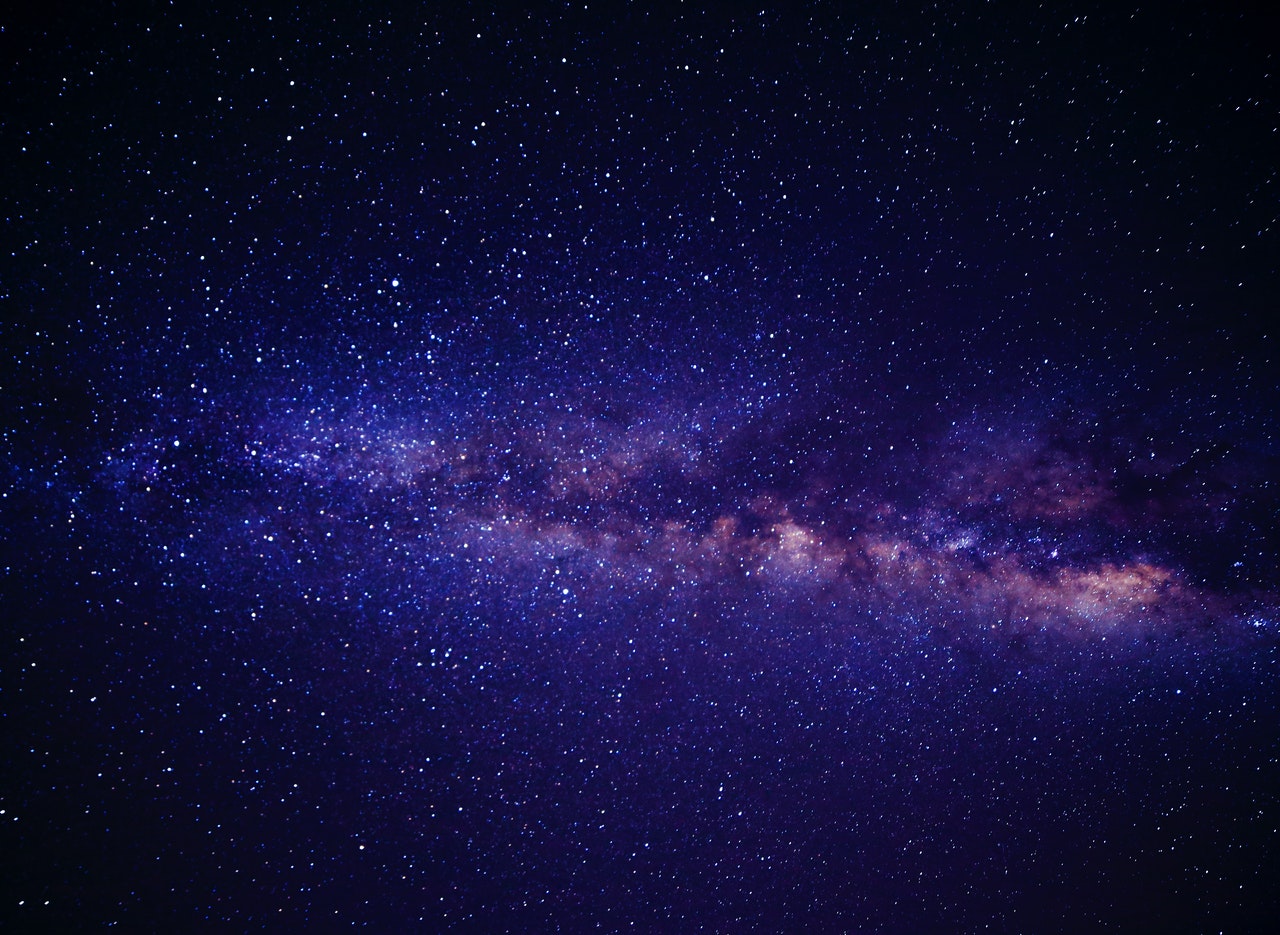
Fast facts:
- As of right now (2021), the cost of booking a trip to space in the near future is approximately $250,000 .
- The immediate cost of a trip to space (via something like SpaceX) in the next 2-3 years is in the tens of millions per passenger .
- In the medium-future, the cost of individual tickets into space will drastically fall in price.
- Based on estimations, it is likely that the cost of space tourism tickets will be around $10,000 – $25,000 within the next twenty years .
How much will it cost for a private citizen to travel to space?
Since the Champion Traveler research team is heavily focused on private travel (as opposed to how much it costs astronauts to fly to space), all data used in this article will be based on the idea of privatized space tourism. This industry is expected to hit a major milestone in the 2020s, and it is likely that space tourism will become not only more common but more affordable within the next twenty to fifty years.
As of right now, based on early estimations from several major private space exploration companies (SpaceX, Blue Origin, and Virgin Galactic), the first privatized space travel will cost adventurous travelers somewhere around $250,000 for a short trip into Earth’s orbit. This quarter of a million dollar price tag for private space tourism will likely include somewhere between a few hours and a few days orbiting the Earth.
This type of space travel will remain expensive for several years, but as all things improve and become more efficient within the process, the cost will very likely start to decrease within a matter of years. There is likely a heavier price tag on the first couple of trips simply because of the historic nature of them. As market demand balances out and more space tourism is available, it seems likely the cost of a ticket for a short adventure into space will be somewhere around $10,000 to $25,000 depending on the length of the trip and the number of passengers included on each flight.
When will space travel become more affordable?
As of right now (2021), space travel is more likely a pipe dream for many than a realistic vacation. A quarter of a million dollars for one trip into outer space is likely not something many people will be able to afford in the short term. But as costs drop and space tourism becomes more efficient (and likely sees more competition), ticket prices for space travel will fall back down to Earth.
As for how long this will take, within 20 years (by about the year 2040), space travel should see a gradual decrease in price to somewhere in the $10,000 – $25,000 range (in 2021 dollars) where it will likely flat line for a while based on current cost estimations of scale, fuel costs, production costs, and regulation.
It is possible that we will see privatized space tourism drop down to somewhere in the $5,000 – $10,000 range as well if more competition enters the market if demand stays high.
Will space travel ever be cheaper than air travel?
The problem with comparing space travel to the current price of air travel is that the current market for air travel remains in high demand for both tourism and business purposes.
In the medium term, the only purpose that space travel as tourism will serve is for quick trips into space and back. There won’t be necessarily, at least in the foreseeable future, a spike in travel demand for business purposes and thus the overall market demand for space tourism will remain relatively small.
Because of this, it is very unlikely that we will ever see space tourism anywhere near comparable flights for something like a transatlantic flight to Europe from the United states for $500-700.
When will space travel be available to more people?
Based on current development of spaceships capable of carrying a larger number of private citizens, we expect that by the 2030s it will be possible to book a ticket via one of the current major space exploration brands (SpaceX, Blue Origin), and that we also will likely see between two and five new companies enter the market in that time.
With a growing number of companies producing spacecraft capable of allowing for space tourism, there will likely be hundreds of available seats in a given year within the next decade, and thousands of available seats a year after that.
Is space tourism safe?
This is something nobody has enough of a firm grasp on to say definitively one way or the other just yet, but it seems fair to assume given how long it has taken to commercialized space travel, that the early flights will take every precaution possible.
It’s fully reasonable to expect that over the course of space tourism expansion there will be accidents and likely death, but at the same time, the same can still be said about traditional air travel. While statistically considered extremely safe, there will always be a minimal amount of risk associated with any type of travel.
What companies offer private space travel?
There are many now-defunct companies who have tried to establish footing in space tourism, but as of now there seem to be three main companies we will be watching closely when it comes to offering one of the grandest possible adventures for private citizens:
- SpaceX – Led by Elon Musk, this company seems the most likely to begin ramping up space tourism within the next two decades. They have a planned launch for their first space tourists in the coming two years.
- Virgin Galactic – Led by Richard Branson, this company has been around the longest (of the surviving companies), but has yet to launch their first commercial space tourists into space.
- Blue Origin – Led by Jeff Bezos, Blue Origin has focused mostly on commercial space travel, but has also discussed expanding their efforts into personal space travel in the near future.
Location Search
About our travel data.
We compile multiple data sources from top tier travel companies around the world to create our guides and advisories. Our goal is to provide critical, timely and accurate information for all of your travel needs.
How much does a trip into space cost?
Advertiser disclosure.
We are an independent, advertising-supported comparison service. Our goal is to help you make smarter financial decisions by providing you with interactive tools and financial calculators, publishing original and objective content, by enabling you to conduct research and compare information for free - so that you can make financial decisions with confidence.
Bankrate has partnerships with issuers including, but not limited to, American Express, Bank of America, Capital One, Chase, Citi and Discover.
How We Make Money
The offers that appear on this site are from companies that compensate us. This compensation may impact how and where products appear on this site, including, for example, the order in which they may appear within the listing categories, except where prohibited by law for our mortgage, home equity and other home lending products. But this compensation does not influence the information we publish, or the reviews that you see on this site. We do not include the universe of companies or financial offers that may be available to you.
- Share this article on Facebook Facebook
- Share this article on Twitter Twitter
- Share this article on LinkedIn Linkedin
- Share this article via email Email

- Connect with Travers Korch on Twitter Twitter
The Bankrate promise
At Bankrate we strive to help you make smarter financial decisions. While we adhere to strict editorial integrity , this post may contain references to products from our partners. Here's an explanation for how we make money .
Founded in 1976, Bankrate has a long track record of helping people make smart financial choices. We’ve maintained this reputation for over four decades by demystifying the financial decision-making process and giving people confidence in which actions to take next.
Bankrate follows a strict editorial policy , so you can trust that we’re putting your interests first. All of our content is authored by highly qualified professionals and edited by subject matter experts , who ensure everything we publish is objective, accurate and trustworthy.
Our banking reporters and editors focus on the points consumers care about most — the best banks, latest rates, different types of accounts, money-saving tips and more — so you can feel confident as you’re managing your money.
Editorial integrity
Bankrate follows a strict editorial policy , so you can trust that we’re putting your interests first. Our award-winning editors and reporters create honest and accurate content to help you make the right financial decisions.
Key Principles
We value your trust. Our mission is to provide readers with accurate and unbiased information, and we have editorial standards in place to ensure that happens. Our editors and reporters thoroughly fact-check editorial content to ensure the information you’re reading is accurate. We maintain a firewall between our advertisers and our editorial team. Our editorial team does not receive direct compensation from our advertisers.
Editorial Independence
Bankrate’s editorial team writes on behalf of YOU – the reader. Our goal is to give you the best advice to help you make smart personal finance decisions. We follow strict guidelines to ensure that our editorial content is not influenced by advertisers. Our editorial team receives no direct compensation from advertisers, and our content is thoroughly fact-checked to ensure accuracy. So, whether you’re reading an article or a review, you can trust that you’re getting credible and dependable information.
How we make money
You have money questions. Bankrate has answers. Our experts have been helping you master your money for over four decades. We continually strive to provide consumers with the expert advice and tools needed to succeed throughout life’s financial journey.
Bankrate follows a strict editorial policy , so you can trust that our content is honest and accurate. Our award-winning editors and reporters create honest and accurate content to help you make the right financial decisions. The content created by our editorial staff is objective, factual, and not influenced by our advertisers.
We’re transparent about how we are able to bring quality content, competitive rates, and useful tools to you by explaining how we make money.
Bankrate.com is an independent, advertising-supported publisher and comparison service. We are compensated in exchange for placement of sponsored products and, services, or by you clicking on certain links posted on our site. Therefore, this compensation may impact how, where and in what order products appear within listing categories, except where prohibited by law for our mortgage, home equity and other home lending products. Other factors, such as our own proprietary website rules and whether a product is offered in your area or at your self-selected credit score range can also impact how and where products appear on this site. While we strive to provide a wide range offers, Bankrate does not include information about every financial or credit product or service.
To boldly go on vacation
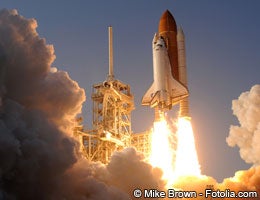
Summer is about to come into view, and along with it, the hordes of luggage-laden minivans heading for the great American vacation. There will be plane flights and train rides, Mount Rushmore visits and Grand Canyon views. It might not be long, though, before we’re all considering a type of trip that Clark W. Griswold would never have attempted: a voyage straight up into space to marvel at the Earth from afar and gaze at the stars like never before.
Space tourism is expected to “take off” in the next decade, with the Federal Aviation Administration predicting it to blossom into a billion-dollar industry in that time.
It’s not all that difficult to imagine, given the technological progression and increasing accessibility since man’s first “timid penetration beyond the confines of the atmosphere,” as cosmonautic patriarch Konstantin Tsiolkovsky forebode a century ago.
The Jetsons’ concept of every average George and Jane scooting around in private saucers was probably inevitable from the launch of the first satellite, Sputnik, in 1957. What followed were decades of space-based machismo between Russia and the United States, one incredible moon landing and a bevy of science fiction that almost made space tourism passe. Almost.
Friends in high places
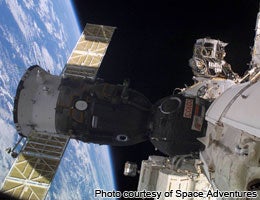
That all changed in 2001 when Dennis Tito decided he wanted to play Neil Armstrong for a few days — tagging along on a trip to the International Space Station. Creator of the Wilshire aggregate market index, Tito shelled out $20 million for the privilege of becoming the first space tourist, spending nearly eight days in space — to the reported chagrin of the actual astronauts involved in the mission who felt he needed more training.
Tito was also the first space tourist client of Space Adventures, which currently is the only company to have sold spaceflights to individuals that have been realized.
“Collectively, our clients have spent over three months in space, traveling over 36 million miles,” says Tom Shelley, president of Space Adventures.
The company offers a wide range of astonishing — and pricey — out-of-this-world experiences that would’ve seemed like fantasy to every nonastronaut (or cosmonaut) at the turn of the century.
Thanks to Space Adventures, you could be the eighth space tourist to orbit the Earth or to dock at the International Space Station. The price tag for such a trip now? Approximately $50 million. What’s more, you’ll probably be put to work with some sort of experiment while you’re up there, so don’t expect there to be any zero-gravity spa treatments included in your pricey package.
The most expensive walk you’ll ever take
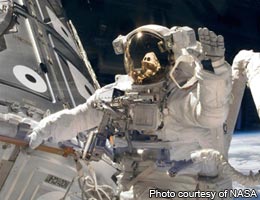
Since you already wrote a check equivalent to the gross domestic product of a small country to see the Earth as so few have seen it, you may as well go all out. For another $15 million, you can stay on the International Space Station for five days to be trained and certified for an “Extravehicular Activity,” otherwise called a spacewalk. For 90 minutes, you will be out in the nothingness of space, realizing exactly how small you really are. You also may be given some menial task to make you feel important and take your mind off of the thought that you’re only one “everything going terribly wrong” away from drifting off helplessly into deep space.
If this still isn’t enough for you and you’ve just won Mega Millions, inquire about Space Adventure’s mission planned for 2017. It might sound like fiction, but they’re planning a circumlunar flight that will be the first human trip to the moon since 1972. As a bonus, you’ll get to do the Jim Lovell/Tom Hanks trick of hiding the Earth and “everything you’ve ever known” under your thumb from 240,000 miles away. The mission provides space for two commercial passengers at a price of $300 million, which is shocking in and of itself until you hear that someone has already reserved one of the seats. We’re going to guess they probably also called “shotgun.”
Space on a budget
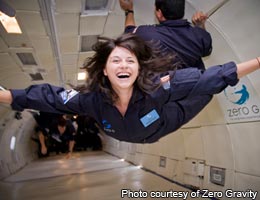
Not every trip into space requires an eight-figure financial hemorrhage. One can still experience the wonders of weightlessness and looking out into black space and bright stars at a fraction of the price. Well, as long as you keep in mind how large the figure is we’re taking a fraction of.
Space Adventure’s subsidiary, Zero Gravity, offers what most people would consider the most horrifying plane ride of their life. And more than 7,000 people have paid about $5,000 to take this fear-inducing plunge. A modified Boeing 727 climbs at a 45 degree angle to 34,000 feet before reversing course and hurtling toward the ground. Each “parabola” provides about 30 seconds of weightlessness.
To “slip the surly bonds of Earth” and truly experience space comes with the next price bracket up. Space Adventures has partnered with Armadillo Aerospace to provide suborbital spaceflights at a price of $102,000 per ticket, with more than 200 tickets already reserved.
XCOR Aerospace, based in the Mojave Desert in California, is yet another space vacation company. It offers a 30-minute flight at 330,000 feet on its Lynx ship at a cost of $95,000, including a $20,000 deposit. The company gave away a free ticket in February, only to find out he is a NASA scientist and may be unable to accept. That’s one major suborbital tease.
Who’s going to space?
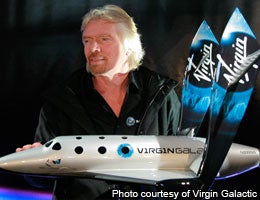
Who can forget the image of Lance Bass posing like he’s going to the astronaut prom? Though his push to reach space fell short, plenty of other celebrities are lining up to reach the stars.
One of the more marketed space tourism projects is Sir Richard Branson’s Virgin Galactic, while currently in testing, may begin suborbital flights in 2013. Last month, Ashton Kutcher became the 500th passenger to sign up for the voyage. The price tag is $200,000 per seat, including a $20,000 deposit. Tom Hanks, Paris Hilton, Katy Perry and Angelina Jolie are reported to have tickets as well.
“We have a very diverse set of customers,” says Sean Wilson, who is with a firm that represents Virgin Galactic. “Some are famous, most are not; some are very wealthy, some are not.”
Public interest is just beginning to gain momentum as more spaceflight firms move closer to realizing their objectives.
“Clients from all walks of life are interested in Virgin Galactic, but at this stage there are not as many people with serious interest and the financial resources to purchase the flight,” says Jennifer Campbell, an owner of Explorations, a luxury travel company that offers flights aboard Virgin Galactic. “For many of the baby boomers that inquire, their interest with space began in the ’60s with Neil Armstrong and moon landings. They grew up with the promise of space travel.”
Sticker shock?
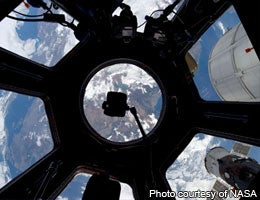
A bulk of what makes up the exorbitant price for commercial spaceflight is wrapped up in the research and development of the still-young commercial industry. It’s one of the rare instances when it is, in fact, rocket science. A launch needed for space flight requires an incredible amount of costly energy and precision.
“The price will always be expensive, but it will reduce in time when more vehicle manufacturers are launching their spacecraft and it’s a competitive environment,” Shelley says.
Wilson says he sees the company’s spaceflight prices possibly moving below $100,000 within the next decade.
“Our aspiration is definitely to bring the price down,” he says. “Historical analogies show that this is likely to happen. Financial success should encourage competition, economies of scale and new technologies, which should all exert a downward pressure on the end price.”
It may never be as cheap as booking a first-class ticket on a transatlantic flight, but the falling price of spaceflight may mean more dreams can come true.
“We know what a life-changing experience seeing the Earth from space is,” Wilson says. “To be able to offer that to individuals from all walks of life and from every country for the very first time is amazing.”
- 5 ways to cut the cost of working
- Organize clutter in your financial life
- 5 common costs where you can save money
- Garden cuts food bill
- Remodelers keen on green
- How to cut laundry costs

Related Articles

How much does it cost to have a baby?

How much does owning a pet cost in a year?

How much does it cost to adopt a baby? 4 possible answers

The cost of attending an awards show
clock This article was published more than 4 years ago

How much does a ticket to space cost? Meet the people ready to fly.
After years of waiting, virgin galactic is close to flying tourists to the edge of space, but it will cost $250,000..

When Lori Fraleigh unwrapped the present her husband had given her for her 38th birthday, she found a curious surprise: a model of a spaceship. It was cool, sure, but a toy would be better suited for her young children, then 5 and 1, not her.
Then she noticed the ticket. It took Fraleigh, a Silicon Valley executive, a moment to realize what her husband had purchased for her: a trip to space with Richard Branson’s Virgin Galactic. “I went through a lot of crazy emotions, like, ‘Did you really buy this?’ ” she recalled of the moment in 2011. “ ‘Do we still have enough money to remodel the kitchen?’ ”
Today, her children are 13 and 9. The kitchen remodel has long since been completed. But Fraleigh is still waiting for her trip to space.
For years, Branson has been pushing a quixotic vision for the future, where his spacecraft would ferry passengers off Earth as frequently as airplanes. But for all the talk about a new Space Age full of citizen astronauts, the journey has been fitful, and filled with setbacks, including the death of a test pilot in 2014 after a harrowing crash.
Virgin Galactic's quest for space
But now, 15 years after Branson founded Virgin Galactic, space tourism could be tantalizingly close to becoming a reality. The company has flown to the edge of space twice and says its first paying customers could reach space next year. Another space venture, Blue Origin, founded by Amazon founder and chief executive Jeff Bezos almost 20 years ago, hopes to conduct its first test flight with people this year, though it hasn’t announced prices or sold any tickets. (Bezos owns The Washington Post.)
And NASA recently announced that it would allow private citizens to fly to the International Space Station on spacecraft built by SpaceX and Boeing.
Which means that Fraleigh may soon finally get her five minutes of weightlessness, a view that promises to be spectacular and a test to see if she has the right stuff.
Fraleigh has dreamed of being an astronaut since she was a kid and has solid space geek credentials, including having attended Space Camp as a teenager.
What’s it really like to live in space? 50 astronauts share their stories
But she didn’t think she could become a NASA astronaut and instead became a tech executive in Silicon Valley, a career that meant her family could absorb Virgin Galactic’s charge ($200,000 per ticket in 2011) without financial hardship. A mother who spends weekends ferrying her children to soccer, baseball and music lessons, she doesn’t look like a thrill seeker. The most adventurous thing she’s done? Driving a go-cart in college, and “I’ve been on some hikes up in Lake Tahoe that were on the strenuous side.”
Now she’s preparing for a ride in Virgin Galactic’s SpaceShipTwo, a sleek spaceplane with a rocket motor strong enough to send two pilots and as many as six passengers more than 50 miles high, where the Federal Aviation Administration says the edge of space begins. The spaceship is tethered to the belly of a large, twin-fuselage airplane that carries it to an altitude of about 40,000 feet. Then SpaceShipTwo is released, fires its engine and rockets off through the atmosphere.
For decades, people have dreamed of such adventures. After the Apollo missions, Pan Am started a waiting list for tickets to the moon that by 1971 stretched 90,000 names long. Famed CBS News anchor Walter Cronkite signed up, as did future president Ronald Reagan. Later, in the 1970s and early 1980s, NASA was so convinced that the space shuttle would, as the name implied, offer regular service to Earth orbit that a committee was formed to sort out the sticky problem of how to choose the first private citizens to fly.
For today’s space companies, it’s anyone willing — and wealthy enough — to pay the steep cost.
NASA said it would cost $35,000 a night for stays on the ISS, and the price to get there is estimated to be $50 million. Virgin Galactic has said it may in the short term raise the price of its tickets, which today cost $250,000.
Despite the high costs, Virgin Galactic expects high demand from the wealthy. While it completes the testing phase of the spacecraft this year, the company projects flying 66 paying customers in 2020, more than 700 in 2021 and nearly 1,000 the following year. By 2023, when it expects to fly 1,562 paying passengers on 270 flights, it plans to have nearly $600 million in annual revenue. Earlier this year, Virgin Galactic announced it would go public by merging with a New York investment firm, a move that Branson said would “open space to more investors and in doing so, open space to thousands of new astronauts.”
Already, 600 people have signed up for what Virgin Galactic describes as a transformative experience of seeing Earth from space, what astronauts call the “overview effect.” That’s more people than have been to space since 1961, when Soviet cosmonaut Yuri Gagarin became the first person in space.
Second thoughts?
Craig Wichner, who runs Farmland LP, an organic farmland investment fund in San Francisco, has been waiting for the opportunity for more than a decade. In 2008, he plunked down several thousand dollars as a deposit to ride on Virgin Galactic’s SpaceShipTwo with a bunch of friends who thought it’d make a great adventure.
“Who wants to do this with me?” a pal said at the time.
“Yep, I’m there,” Wichner responded.
But it wasn’t just the adventure that attracted Wichner; it was the opportunity to help push humanity out of the atmosphere, he said. Buying a ticket was like casting a vote for Branson’s spacefaring vision of the future — “my way of actually supporting his mission, his dream and helping advance humanity.”
In the years since, the dream has unfurled slowly as Virgin Galactic learned that building a spacecraft was not as easy as initially thought. But the repeated delays had an upside. They allowed Wichner to meet many of the other “future astronauts” who’d signed up with Virgin Galactic, space enthusiasts from 60 countries who now form a sort of exclusive fraternity. They meet occasionally, bonding over the prospect of a wild adventure.
“It was just this wonderful, eclectic mix of people from all around the world,” Wichner said.
Now, as the company gets closer to flying and his number may soon be called, there are other factors to consider. Weighing on Wichner is the realization that spaceflight is dangerous. In 2014, during a test flight, the spacecraft came apart, killing Michael Alsbury, one of the test pilots and a father of two.
Wichner’s reaction to the crash was “a general sadness at the cost.” But he was also inspired by the company’s perseverance, “the unwavering commitment to just keep moving forward,” he said.
Now, however, the opinions of his own children, ages 13 and 8, matter. They’re old enough to understand the consequences of failure.
“Sometimes they’re excited about me going into space, and sometimes they’re scared,” he said. “And so it’s not worth doing if they’re scared.”
NASA’s first ordinary citizen astronauts
NASA’s leaders were convinced that the space shuttle could turn ordinary citizens into astronauts and set about trying to decide which private citizens should go first.
“Space flight belongs to the public; they pay for it,” reads a NASA memo from 1982. “Therefore NASA’s objective has been to maintain the openness of the program and to invite the public to participate to the extent possible. Now a new opportunity has emerged. With the advent of the Shuttle, people need no longer participate vicariously but may participate directly.”
At the time, NASA Administrator James Beggs “was being barraged by people wanting to fly,” said Alan Ladwig, who ran what NASA called its “spaceflight participant program.” “He was getting all these VIPs and reporters calling him and saying they wanted to fly."
The singer John Denver was among those keen to go. He lobbied NASA for a ride, touting that he was an airplane pilot and an amateur astronomer who kept in shape by running four to five miles a day.
“If given the opportunity, I would go tomorrow,” he said at a Senate hearing about flying private citizens on the shuttle.
In 1984, NASA surveyed artists about the prospect of a writer or painter going to space and got this response from Maya Angelou, the award-winning poet, according to a Chicago Tribune article from the time:
“As poets over the centuries concentrated on Grecian urns, nightingales, ravens and romantic love, I am certain that poets in the future will focus on the configuration of planets, stars, weightlessness and the discovery of our universe.”
Ultimately, NASA decided to take people who could communicate the experience to others. First a teacher, then a journalist. NASA leaders “felt astronauts weren’t the greatest storytellers,” Ladwig said. “Some of which was true, some not so true. A lot of them were miffed that people criticized their communication ability.”
But first came a pair of powerful politicians.
Jake Garn, a Republican senator from Utah who headed the appropriations subcommittee that oversaw NASA’s budget, pushed to go, saying it was his obligation to “kick the tires” of NASA’s newest spacecraft. Less than a year later, Bill Nelson, then a Democratic congressman representing the Florida Space Coast, hitched a ride. There were also many non-NASA astronauts known as payload specialists who worked on specific projects in space and often had a particular technical expertise.
The White House, though, was looking forward to the flight of another civilian, Christa McAuliffe, a teacher from New Hampshire, who had been selected out of 11,000 applicants to fly on space shuttle Challenger in 1986. And NASA was deep in the process of picking the next civilian to fly — a journalist — when on Jan. 28, 1986, the Challenger’s booster exploded, killing McAuliffe and the other six astronauts on board. The shuttle would stay grounded for more than 2½ years and never achieve the frequency of flight NASA leaders had initially envisioned, averaging fewer than five flights a year.
No journalist ever flew. And the dreams of opening the shuttle to the general public were deferred.
Preparing for flight
While NASA shied away from flying private citizens after the explosion, the private sector kept pursuing it. In 2004, a venture backed by Paul Allen, the billionaire co-founder of Microsoft, made history when it flew the first private vehicle to the edge of space to claim the $10 million Ansari X Prize .
The flights were heralded as a new Space Age, one where the private sector would end the government’s monopoly on space. But while the SpaceShipOne flights were successful, they were also harrowing; in one, the navigation system went awry and the pilot had to fly blind; in another, the spacecraft spun like a top all the way to space.
Worried that someone would die in his spacecraft, Allen sold the rights to the technology to Branson, who set off to build the bigger, more robust SpaceShipTwo. And after the X Prize, Congress took notice, growing concerned over what they saw as dangerously loose regulations governing the industry. Former congressman James Oberstar, of Minnesota, criticized the FAA as having a “tombstone mentality — wait until someone dies, then regulate.”
The industry pushed back, saying burdensome rules would stifle a growing industry just as it was getting started, and, backed by the FAA, was able to keep the regulations relatively lax. So today, space tourism, like bungee jumping or skydiving, is governed under an “informed consent” standard: Passengers acknowledge they understand the considerable risks, and zoom, off they’ll go to space. And to secure a launch license from the FAA, the companies have only to demonstrate how they will protect people and property on the ground in the event of a crash.
Late last year, two pilots flew Branson’s SpaceShipTwo to the edge of space. Though it did not go into orbit, it was the first launch of a spacecraft with humans from U.S. soil since the space shuttle was retired in 2011.
Then, in February, Virgin Galactic repeated the feat, this time with a crew member, Beth Moses, whose job is to prepare Virgin’s customers for their rides to space. For her, the trip was “mind-blowing,” as if “the sands of time of your life have stopped for a moment.”
Now that Virgin Galactic is getting closer to flying customers, Moses is starting to prepare them to make sure they get the most from the experience. “The one question I ask every one of our customers long before training is what do you most want to get out of your spaceflight?” she said. Some “want to do somersaults,” others want “a Zen, private experience.” Others are flying “to honor someone. . . . It’s an amazing variety.”
But she knows some will have concerns. Part of her job is to allay them, so participants “arrive ready to savor your space experience,” she said. “If you are concerned about any aspect of the flight, that’s what we’ll walk through and just explain it.”
Dee Chester, a 62-year-old retired schoolteacher from Newport Beach, Calif., bought her ticket in 2017, when she came into her inheritance. She said she has no hesitation about going and can’t wait for when her “little nose prints are on every window” of the spacecraft. “I want to do the Superman pose, and look at the Earth and see the very thin bands of the atmosphere. I just hope I’m not crying and miss it all because it’s a big wet blur.”
Now that his day of flying is getting closer, Wichner is getting excited, as well. But he still needs to have the frank conversation with his children, who remain wary.
“It’ll happen naturally, and I think they’ll be fine with me going,” he said.
Until they are, he won’t commit, leaving the future uncertain: “I don’t know that I’m actually going to go.”
How to dress for space: Explore five iconic spacesuits in 3-D
Moonrise: Uncover the real origin story behind the United States’ decision to go to the moon
Follow The Post’s coverage of space

- Search Please fill out this field.
- Manage Your Subscription
- Give a Gift Subscription
- Sweepstakes
- Space Travel + Astronomy
13 Things Tourists Should Know Before Traveling to Space, According to Astronauts
We asked the pros for their best tips on handling a first trip to space.
:max_bytes(150000):strip_icc():format(webp)/Stefanie-Waldek-7eed18a8c9734cb28c5d887eb583f816.jpg)
For most of human spaceflight history, those lucky enough to reach the stars were professional astronauts hired and trained by government agencies around the world. But since the early 2000s, when seven intrepid travelers paid millions to spend a few days aboard the International Space Station (ISS), space tourism has begun to take off. We're now on the cusp of a new era of space exploration, with commercial companies like Virgin Galactic and Blue Origin launching spacecraft capable of taking paying travelers beyond the Earth's surface.
We spoke with former NASA astronauts Leroy Chiao and Scott Parazynski to get their tips for first-time spaceflight participants. During his 15 years with NASA, Chiao participated in four missions — three aboard the space shuttle and one to the ISS, in which he served as commander. Parazynski worked at NASA for 17 years, flying five shuttle missions throughout his career. Read on to discover what they think aspiring space tourists need to know.
Your only job on the flight will be to kick back, relax, and enjoy the ride.
If you're taking a suborbital flight, which is what companies like Virgin Galactic and Blue Origin have offered, your ride will be a quick up-and-down to reach space, rather than a full orbit of the Earth. The short journey is relatively easy compared to what professional astronauts experience. For starters, you won't need to worry about flying your spacecraft. That's all up to the spaceflight provider. "You won't have any responsibility other than to enjoy the experience — and not kick anyone else in the head," says Parazynski. "Their obligations on the flight are pretty straightforward."
As such, the training programs for suborbital space tourist experiences are relatively minimal, perhaps only a few days in length at most. "The downside of not having a lot of training is that you don't have the confidence that comes from lots of training," says Parazynski. "Contrast that with the training I had on the space shuttle, where we trained for hundreds and hundreds of hours for launching in space. If something were to go awry, we would know exactly what to do and our hearts wouldn't skip a beat."
So, other than learning to place your complete trust in your spaceflight provider, Parazynski recommends talking to people who have flown before in order to ease any nervousness. Chiao agrees: "The best advice I can give on launch — and it's easy to say, harder to do — is to try to relax and enjoy the whole process," he says. "Pay attention during your training, talk to other people who've been there if you can. And actually, you might be surprised — it's quite calm!"
Make sure you’re physically and mentally fit.
"I think people should treat this as their Olympics or Super Bowl. This is a really big life experience, and though you don't need to be an Olympic athlete or a Super Bowl champion to fly in space, it helps to be fit," says Parazynski. After all, your body will be experiencing quite a range of new sensations during your spaceflight."
But it's not just about physical fitness — mental fitness is key, too. "I think through fitness comes mental acuity as well," says Parazynski. "The more you can be engaged in the experience, the more you'll remember of it — it'll be more impactful to you."
The G-forces experienced on launch and reentry are not as intense as you might expect.
If you've ever watched a livestream of an astronaut launch, caught any Hollywood flick about space travel, or ridden Mission: Space at Walt Disney World's Epcot theme park, you know that during launch, astronauts get crushed back into their seats. (And, actually, during reentry, too!) They're experiencing strong G-forces, or a sensation of weight felt during acceleration. It's the same feeling you get when you speed up quickly in a car or zoom through a loop or a sharp curve on a roller coaster, but during a rocket launch, those forces are stronger and more sustained. While the experience might seem a little terrifying, the pros say it's quite manageable.
"The G-forces aren't nearly as bad as they show in the movies," says Chiao. "If you're good enough to be given medical approval to go on a trip like this, you're not going to have any problems handling the G-forces." He also notes that you'll likely go through centrifugal runs during your training to prep for the sensation — you'll be strapped into a spinning machine that lets you experience strong G-forces, just like that spinning amusement park ride where you're pressed against the wall and the floor drops.
But to make launch and reentry as comfortable on your body as possible, you'll want to physically relax your muscles so you don't fight against the G-forces. "If you relax and let your body sink into the launch couch, you're going to tolerate it much better," says Chiao. "If you're rigid, that's where you might hurt yourself. And make sure your limbs and arms are inside of the couch."
To prep for weightlessness, you should book a zero-gravity flight.
While it takes quite a bit of effort (and time and money) to get into space to experience weightlessness, you can actually experience the sensation right here on Earth — or rather, just slightly above it. All you need to do is book a zero-gravity flight , where a plane flies in a series of parabolas (or arch-like shapes) during which passengers experience simulated weightlessness through free fall.
It's physically the same as skydiving or even riding a roller coaster, but in those two instances, your senses tell you you're actually falling. "When you're in a zero-G airplane, the airplane is falling at the same rate you are, so you're floating inside the airplane," says Chiao. "That's what it's like in a spacecraft when you get up into space and the engines cut off."
Through commercial companies like the Zero Gravity Corporation , anyone who can spare the cost of a ticket can experience weightlessness — and anyone who's planning on making a trip to space should definitely give it a go. "If they have the means, they should get on a zero-G flight before they go on a suborbital flight," says Parazynski. "It would take some of the mystery out of 'what am I going to feel like?' and 'how do I move?'"
Learning how to scuba dive is good weightlessness training, too.
While being underwater isn't exactly like floating in space, it's a pretty good way to practice moving around in a weightless environment. In fact, NASA even has a life-sized replica of the ISS set inside a giant pool, so astronauts can train for spacewalks underwater.
"Moving in weightlessness comes to you very quickly when you spend some time underwater," says Parazynski. "Get neutrally buoyant underwater and very gently try and move yourself along the ocean floor or bottom of your pool. It doesn't take a lot of force, but it does take a lot of thought."
Come up with a game plan for your few minutes in space.
On suborbital flights, you're only going to have a few minutes in weightlessness, so you should plan exactly how you want to spend your time up there. Figure out if you'd like to bring a memento like a family photo or college pennant for a fun picture. (U.S. Naval Academy graduates and former astronauts Wally Schirra and Tom Stafford famously put a "Beat Army" sign in the window of their Gemini VI spacecraft, so there's a long tradition of this.) Decide in advance if you want to attempt what spaceflight veterans call "stupid astronaut tricks," like flips or spins. But most importantly, budget time to look out the window.
"The most important thing I would tell future astronauts is to savor the view out the window," says Parazynski. "It's, for lack of a better term, a God's-eye view, and so few people have ever had a chance to see it. It's really a beautiful thing to be hovering in space and looking down at your planet."
Don’t worry about taking your own photos.
"As far as taking photographs, I don't know that I would recommend it," says Chiao. "You're not going to be very good at it, first of all, because it takes a little bit of practice to get used to zero-G. Don't waste that time taking photos. Get your memories, look out those windows, and enjoy the whole experience of being weightless." Plus, given the price tag of these spaceflights, we're pretty sure that your operator will provide you with photos and videos of your journey anyway.
When you get into zero gravity, you might feel a little dizzy.
The body functions a bit differently when you remove gravity from the equation for a sustained period of time, and side effects may include dizziness and nausea. "You're going to feel full-headed because there's no longer gravity pulling fluid down into your legs," says Chiao. "And so all that fluid comes up into your torso, and you can feel it right away. It feels kind of like you're standing on your head."
But the good news is, on suborbital flights you might be able to avoid the worst of it. "The adrenaline and excitement are going to make you do OK at first, and by the time you might start feeling bad, it's time to strap back in and come back down," says Chiao.
If you’re spending a few days in space, be prepared for some bumps and bruises.
On a suborbital flight, you won't have a ton of time in space, so you won't really have to worry about acclimating to zero gravity. However, some private spaceflight companies are looking to send their clients up into orbit for longer stays and there are even talks of a space hotel within Voyager Station . If you're going to spend a few days or even a few weeks up in space, you're probably going to bump your head more than once, no matter how much you've trained for the experience.
"It's really funny watching rookie astronauts the first day or two up on a mission," says Parazynski. "We called them the bull in a china shop. They push off with full force and they crack their skull or bang their knee."
You’re also going to make a mess.
Doing routine tasks like brushing your teeth (you can't just spit your toothpaste into a sink), clipping your fingernails (you don't want them floating off into your space station), and going to the bathroom (have you ever thought about how to use a toilet without gravity?) are all very different experiences in weightlessness. Inevitably, you might have a few mishaps early on in your trip.
"Just sitting down for a meal, you put your fork down, and it's gone in 30 seconds," says Parazynski. "You may find it two days later in the cabin air cleaner because that's where the air currents have taken it." Luckily, a lost fork is an easy mess to clean up — and the situation can be prevented by tethering it down. Other messes are a different story.
"As far as using the restroom, that's what you need to pay attention to during your training. The toilet is not particularly simple and you have to be careful," says Chiao. (In case you were wondering, space toilets use airflow to guide things where they're supposed to go.) "But be prepared to make some messes," says Chiao. "And everybody has to clean up their own mess."
If you’re going to do a spacewalk, the stakes are much higher for you and your crew.
If you want to zip around space with a jetpack like George Clooney in "Gravity," sorry, but chances are that's not going to happen any time soon. Most private astronauts will be safely tucked inside their craft for the duration of their flight.
Unlike suborbital flights, future orbital flights with a spacewalk will require extensive training, given that spacewalks are inherently more dangerous than simply riding in a vessel. "If you're careless with your tethers and you float off into the void, there's not a whole lot anyone can come do for you," says Parazynski. It's possible that a crewmate may be able to head out to rescue you, but then you're endangering their life as well. "It's paramount for a spacewalker to think not just about their own health and well-being and their experience, but also that of their crewmates," he says.
If you’re in a capsule, be prepared for a bumpy landing.
While the only way up to space is by rocket, there are two ways to come back down: via a winged vehicle, like the space shuttle or Virgin Galactic's SpaceShipTwo, or a capsule, like Apollo, Soyuz, and Blue Origin's New Shepard. The experiences are quite different, as winged vehicles land like an airplane on a runway, whereas capsules descend beneath parachutes onto land or water. While both experience a range of G-forces during reentry, capsules have a bit of a rougher ride, particularly at the very end.
"When the parachute comes out, you can expect to get jostled around a fair amount, so that can be disorienting," says Chiao. "Then, whether you're hitting the water or the ground, you're gonna get a good bump. There are shock-absorbing mechanisms, of course, that make it not too big a deal. But on Soyuz, you smack the ground pretty darn hard. It was kind of surprising!"
It’ll be worth every penny.
Sure, it's going to cost a small fortune to go into space as a tourist — for now, that's somewhere in the ballpark of several hundred thousand dollars for a suborbital flight and millions of dollars for longer-duration orbital stays. But ask any astronaut, and they're sure to tell you it'll be worth the investment.
"What I would tell prospective astronauts is that it's going to change their lives forever," says Parazynski. "It's a perspective that can't be captured in emotion on film. Even in 3D IMAX, there's no way to capture the way it's going to make you feel, the connectedness you feel to planet Earth, and the awe you have when you look out into the universe."
Space Tourism: Can A Civilian Go To Space?

2021 has been a busy year for private space tourism: overall, more than 15 civilians took a trip to space during this year. In this article, you will learn more about the space tourism industry, its history, and the companies that are most likely to make you a space tourist.
What is space tourism?
Brief history of space tourism, space tourism companies, orbital and suborbital space flights, how much does it cost for a person to go to space, is space tourism worth it, can i become a space tourist, why is space tourism bad for the environment.
Space tourism is human space travel for recreational or leisure purposes . It’s divided into different types, including orbital, suborbital, and lunar space tourism.
However, there are broader definitions for space tourism. According to the Space Tourism Guide , space tourism is a commercial activity related to space that includes going to space as a tourist, watching a rocket launch, going stargazing, or traveling to a space-focused destination.
The first space tourist was Dennis Tito, an American multimillionaire, who spent nearly eight days onboard the International Space Station in April 2001. This trip cost him $20 million and made Tito the first private citizen who purchased his space ticket. Over the next eight years, six more private citizens followed Tito to the International Space Station to become space tourists.
As space tourism became a real thing, dozens of companies entered this industry hoping to capitalize on renewed public interest in space, including Blue Origin in 2000 and Virgin Galactic in 2004. In the 2000s, space tourists were limited to launches aboard Russian Soyuz aircraft and only could go to the ISS. However, everything changed when the other players started to grow up on the market. There are now a variety of destinations and companies for travels to space.
There are now six major space companies that are arranging or planning to arrange touristic flights to space:
- Virgin Galactic;
- Blue Origin;
- Axiom Space;
- Space Perspective.
While the first two are focused on suborbital flights, Axiom and Boeing are working on orbital missions. SpaceX, in its turn, is prioritizing lunar tourism in the future. For now, Elon Musk’s company has allowed its Crew Dragon spacecraft to be chartered for orbital flights, as it happened with the Inspiration4 3-day mission . Space Perspective is developing a different balloon-based system to carry customers to the stratosphere and is planning to start its commercial flights in 2024.
Orbital and suborbital flights are very different. Taking an orbital flight means staying in orbit; in other words, going around the planet continually at a very high speed to not fall back to the Earth. Such a trip takes several days, even a week or more. A suborbital flight in its turn is more like a space hop — you blast off, make a huge arc, and eventually fall back to the Earth, never making it into orbit. A flight duration, in this case, ranges from 2 to 3 hours.
Here is an example: a spaceflight takes you to an altitude of 100 km above the Earth. To enter into orbit — make an orbital flight — you would have to gain a speed of about 28,000 km per hour (17,400 mph) or more. But to reach the given altitude and fall back to the Earth — make a suborbital flight — you would have to fly at only 6,000 km per hour (3,700 mph). This flight takes less energy, less fuel; therefore, it is less expensive.
- Virgin Galactic: $250,000 for a 2-hour suborbital flight at an altitude of 80 km;
- Blue Origin: approximately $300,000 for 12 minutes suborbital flight at an altitude of 100 km;
- Axiom Space: $55 million for a 10-day orbital flight;
- Space Perspective: $125,000 for a 6-hour flight to the edge of space (32 km above the Earth).
The price depends, but remember that suborbital space flights are always cheaper.
What exactly do you expect from a journey to space? Besides the awesome impressions, here is what you can experience during such a trip:
- Weightlessness . Keep in mind that during a suborbital flight you’ll get only a couple of minutes in weightlessness, but it will be truly fascinating .
- Space sickness . The symptoms include cold sweating, malaise, loss of appetite, nausea, fatigue, and vomiting. Even experienced astronauts are not immune from it!
- G-force . 1G is the acceleration we feel due to the force of gravity; a usual g-force astronauts experience during a rocket launch is around 3gs. To understand how a g-force influences people , watch this video.
For now, the most significant barrier for space tourism is price. But air travel was also once expensive; a one-way ticket cost more than half the price of a new car . Most likely, the price for space travel will reduce overtime as well. For now, you need to be either quite wealthy or win in a competition, as did Sian Proctor, a member of Inspiration4 mission . But before spending thousands of dollars on space travel, here is one more fact you might want to consider.
Rocket launches are harmful to the environment in general. During the burning of rocket fuels, rocket engines release harmful gases and soot particles (also known as black carbon) into the upper atmosphere, resulting in ozone depletion. Think about this: in 2018 black-carbon-producing rockets emitted about the same amount of black carbon as the global aviation industry emits annually.
However, not all space companies use black carbon for fuel. Blue Origin’s New Shepard rocket has a liquid hydrogen-fuelled engine: hydrogen doesn’t emit carbon but simply turns into water vapor when burning.
The main reason why space tourism could be harmful to the environment is its potential popularity. With the rising amount of rocket launches the carbon footprint will only increase — Virgin Galactic alone aims to launch 400 of these flights annually. Meanwhile, the soot released by 1,000 space tourism flights could warm Antarctica by nearly 1°C !
Would you want to become a space tourist? Let us know your opinion on social media and share the article with your friends, if you enjoyed it! Also, the Best Mobile App Awards 2021 is going on right now, and we would very much appreciate it if you would vote for our Sky Tonight app . Simply tap "Vote for this app" in the upper part of the screen. No registration is required!
Book Your Reservation
*For non-US Customers: We do not collect customer State/Province information in order to complete your deposit. You may continue to complete your deposit with the “State/Province” field disabled.
We will never sell your personal data. It will only be used to process your order and support your experience. For more information, please read our privacy policy .
Space A Travel: Everything You Need To Know
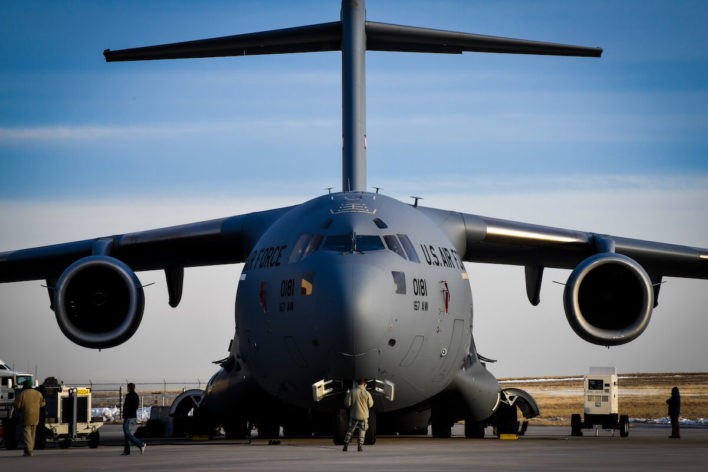
Julie Provost
What is Space-A Travel?
Table of Contents
Space-A is being able to travel on DOD aircraft for free or at a limited cost. The flights you take are on a space-available basis, and the number of passengers they take will depend on the flight. Space-A can get you to many different places worldwide, but some locations are more challenging to fly to than others.
When you fly Space-A, you have to do some planning and research. You must know which Space-A category you fall into and what that will mean for flights. You will need to make sure you are eligible and have all the right paperwork. You can travel with children, but you do need to be prepared for the whole trip, and that might be more difficult than flying commercially.
What Are the Different Categories for Space-A Travel?
Those who are eligible for Space-A typically fit into one of six different categories. These categories help determine how likely it is that you can fly.
Category I : Emergency Leave Unfunded Travel- For emergency situations only.
Category II: EML (Environmental Morale Leave) for Active Duty and dependents.
Category III: Active Duty Ordinary Leave- This category also includes those on Terminal Leave as well as their accompanied dependents, those on House Hunting Permissive TDY, Medal of Honor Holders, and dependents of deployed service members as long as they are deployed for 365 consecutive days or more. It is important to note that these dependents will be selected behind active duty members no matter when they sign up.
Category IV: Unaccompanied Dependents on EML or dependents whose sponsor is deployed between and including 30-364 days as well as DODDS teachers on EML during the summer.
Category V: Unaccompanied command-sponsored and non-command-sponsored dependents of active duty, permissive TDY (non-house hunting), and students.
Category VI: 100% disabled veterans. Retirees as well as their accompanied Dependents, reserve, ROTC, NUPOC, and CEC. The DoD adds, “Surviving Spouses of service members who died while on active duty, inactive duty training, or annual training status. as well as retired military members, and their accompanying dependents.”
Can Retirees Fly Space-A?
Retired military members who are issued DD Form 2 and eligible to receive retired or retainer pay may use Space-A travel according to the Air Mobility Command Space-A official site.
RELATED : Disabled Veterans Can Now Fly Space-A
Are You Able to Travel Without Your Service Member?
Only eligible dependents whose service member is stationed overseas can travel unaccompanied and would do so as CAT-V, with some CONUS restrictions. Those whose service member is deployed for 30 days or more may travel unaccompanied anywhere that Space-A is allowed at a CAT-III, after active duty, or CAT-IV, based on how long they are deployed, as mentioned above. If your spouse is not deployed and stationed in CONUS, you can not use Space-A unless you are with your service member.
What About National Guard or Reserve Members?
At press time, Space-A travel is authorized for National Guard/Reserve components/members of the Ready Reserve and members of the Standby Reserve who are on the Active Status List.
What Do You Have to Do to Get On A Flight?
The first step is get authorized to travel on Space-A. This means starting leave if you are on active duty or getting a travel letter if you are an unaccompanied dependent. If you are a retiree, you should be authorized when you are ready to start the process.
- Sign up and register at the locations you plan to travel to and from. You can do this at some terminals through an online form, in person, by email, or by fax. This signing up doesn’t mean you are on a flight or have an exact flight time. What you will be doing is getting assigned a date and time. This will put you in front of anyone in your category who has a later date and/or time than you do.
- Sign up as soon as possible for as many places as you think you might go. If you are unsure where you will be flying from, sign-up for all potential places. You don’t want to sign-up too far in advance so that your sign-up expires before the date you want to fly. For active duty, you should sign-up as soon as your leave starts, and that sign-up should last until your leave is over. For non-active duty, sign-ups are valid for 60 days.
- Each sign-up location is independent. Call to verify that you are signed up and carry a printed copy of your emails verifying you have done so. That way, you can show that you should be on any list you need to use to travel.
Showing Up for a Flight
- Show up before any potential flight you want to take. Flights will get posted, and you can make your plan from there. You need to mark yourself “Present” for the flight you want to go on. This tells the terminal that you are there and will be ready to fly when the time comes.
- When exactly you are marked “Present” doesn’t matter as far as where you are in line; the date and time of when you signed up does, but you would need to be marked present within 24 hours of flight time.
- It is a good idea to get to the terminal, ready to fly with all of your bags and paperwork, about an hour before what is called “Show Time.” You would then mark yourself “Present” by checking in at the desk and wait until “Show Time.” At this point, you do not want to leave the area, even to grab a bite to eat. Times can change, and you want to be ready if that happens.
Show Time and Roll Call
- “Show Time” is when “Roll Call” can begin, and it is about 2-3 hours before it would be time to fly. You need to be aware of when “Show Time” is supposed to start, as well as what time you would fly if you make it on the flight. Always give yourself extra time.
- “Roll Call” is going to be when the date and time you “signed up” for that location and the category you are in come into play. With “Roll Call,” they start with CAT-I and go through all the way until CAT-VI or until they fill all the seats. For example, someone in CAT-IV, who signed up on June 1st at 10:30 am will be ahead of someone who signed up for CAT-IV, on June 1st, at 11:30 am. All of CAT-IV would be ahead of all of CAT-5. They might just have 10 seats, or they might have 50 seats, it depends on the flight, aircraft, and how much space they actually have on the flight.
- You will need to be right there during “Roll Call.” If you are somewhere else, and they call your name, and you don’t check-in, you will not make it on the flight. You will need to be travel-ready when this happens.
- Being “Manifested” means you are selected for a flight, and you will be going on this flight unless the flight itself is canceled or you get bumped for cargo. This is where you want to be.
- You can also be “Manifested Through,” which means you won’t have to compete for a seat on your second flight. However, you need to make sure you are “Manifested Through” to your end location. This, however, does not mean you have your round trip covered. You will have to compete for seats on your return trip.
How Much Does Space-A Travel Cost?
Many Space-A flights are free; however, if you take a Patriot Express flight, you may be charged a head tax and inspection fees. Bring cash for this flight, you may not be permitted to pay using a credit card.
You may also need to have extra money for possible stays in hotels, extra food, or even money for transportation. Because some flights get canceled, or it can be hard to get on right away, you might have to wait near the terminal for a few nights.
How Many Bags Can You Bring?
For Space-A, the nature of the mission determines how much baggage can be loaded. On some flights, you may be allowed to bring two pieces of luggage each, not to exceed 70 lbs. For others, there may be a requirement for the bags to be under 30 lbs.
Where Can You Go For Extra Help?
- The Air Mobility Command website – This is where you can read information about how Space-A works, sign up for flights, and more.
- SpaceA.net – An informational site about the ins and outs of Space-A travel.
Other Tips For Flying Space-A?
The main thing you need to remember is that Space-A is going to require some planning. You will need to spend some time researching where you will go, how many flights they have, and how easy it might be for you to get on a flight. Certain times of the year are busier than others, and you must bring your patience.
Flights can get delayed for days. You might go through the entire process and end up on a flight, only to have to get off and start all over again because there is something going on with the plane. You need to plan for if your first idea doesn’t work out.
There are a lot of benefits to flying Space-A. You can see the world and can do so without having to spend a lot of money, but you have to understand that you will have to work for it. Some flights will be easier than others, and you just never really know what you will find when you attempt to fly Space-A.
If you need to reach your destination by a certain date, Space-A might not be the best way to get there. Unlike a commercial airline, you are not guaranteed a time and a place to fly. Being flexible and understanding is a must. If you can go into Space-A with that mindset, you can enjoy everything Space-A has to offer.
- Airlines with Military Discounts
- Disabled Veterans Can Now Fly Space-A
- Delta Airlines Military Discount
- Summer Travel Discounts for Military Families
- Best Vacations for Military Families in the US
- Hotels with Military Discounts
Featured Posts
- Find Your Next Base: List of Military Installations by State
- Military Benefits Guide
- TRICARE Basics
- GI Bill Benefits Guide
- Guide to Private Life Insurance for the Military
- VA Home Loan Benefits Guide
- Naval Base San Diego Guide
- Los Angeles Air Force Base Guide
- Marine Corps Base Quantico Guide
Recent Posts
- Joining a Military Association
- What to Know About the VA Caregiver Support Program
- Lower TRICARE Copays For Specialty Drugs
- New Proposed Legislation Could Boost Military Pay, Childcare
- DoD Expands Military Spouse Employment Options Overseas
- Supreme Court Decides GI Bill Case In Favor of Veterans
- DoD Expands Universal Pre-K to “Most Schools”
- Resources for Disabled Veterans
- Foreclosure Avoidance for Veterans: Veterans Affairs Servicing Purchase Program
- Federal Income Tax Filing Extensions For Military Members
Most Popular Articles
- COLA to Increase 5.9% for Retirees, Disabled Veterans in 2022
- Costco Military Discount
- Fly for Less: Military Discount Flights for Veterans & Military
- Lowe’s Military Discount for Military and Veterans
- Disneyland Military Discount
- Military Discounts on Golfing & Golf Gear
- Disney World Military Discount
- Free TSA PreCheck for Military
- Waves of Honor: Discounted Admission for Military & Veterans
- Sam’s Club Military Offer
5 Military Automobile Discounts for 2024

Read More 883 WORDS
Atkins Military Discount

Read More 183 WORDS
Avocado Green Mattress Military Discount

Read More 228 WORDS
Find VA Approved Colleges that Accept Military & Veteran Benefits
Get Started
Search nearly 3000 VA-approved school profiles to find your perfect fit
HALO Space unveils capsule design for stratospheric space 'glamping'
A Spanish balloon company plans to begin flying paying space tourists in 2026
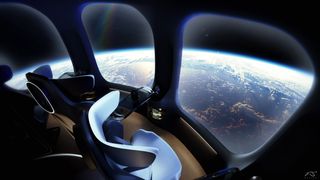
LONDON — Stratospheric balloon company HALO Space plans to offer aspiring space travelers the space tourism equivalent of glamping. Instead of tight space suits and stomach-churning G-forces typically attached to a rocket flight, the company's pressurized capsule, attached to a helium-filled balloon, will offer comfy swivel seats, giant windows and a selection of fine cuisine.
The Spanish-headquartered firm unveiled the design of the 3.9-ton (3.5 metric tonnes) Aurora capsule at an event in London on Wednesday, April 10, and said it hoped to begin commercial operations in 2026.
Unlike suborbital space tourism companies such as Virgin Galactic and Blue Origin , HALO Space won't be taking passengers high enough to experience weightlessness . The flight will be a rather leisurely affair lasting up to six hours, almost four of which will be spent hovering in the stratosphere some 22 miles (35 kilometers) above Earth's surface. There, high above the cloud tops, passengers will be able to admire the star-studded blackness of space above, as well as the curvature of the planet shrouded in the atmosphere beneath their feet.
Related: Space Perspective is nearly ready to fly tourists on luxury balloon rides near the edge of space (exclusive)
"When you talk to astronauts, they tell you that this experience of watching the planet from above is really something unique and extraordinary," HALO Space CEO Carlos Mira said in the press conference. "So far, only 650 humans have had the opportunity to experience this overview effect. But you don’t need to go all the way to space to have it. We hope to offer this experience to 1,000 people by 2030."
HALO Space is one of two companies currently readying its balloon technology to begin commercial operations in the next two years. The other is Florida-based Space Perspective, which revealed a completed test model of their Spaceship Neptune in February. HALO Space said they have conducted five test flights with a mockup and plan to take off for the first crewed test in 2025 before commencing flights with paying passengers a year later.
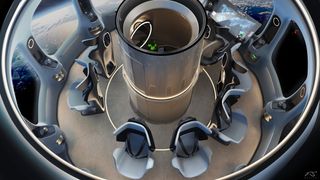
Both companies hope their propositions will attract a wider customer base than the jerky rocket rides of Blue Origin and Virgin Galactic, which propel daredevil clients on short joy rides to the edge of space and back. Reaching an altitude nearly three times higher than stratospheric balloons, Virgin Galactic and Blue Origin's spacecraft experience several-minute-long spells of microgravity before falling back to Earth .
Get the Space.com Newsletter
Breaking space news, the latest updates on rocket launches, skywatching events and more!
At $164,000 per seat, a trip with HALO Space will cost about a third of the price of a Virgin Galactic flight and won't require any advanced medical certifications.
"The take-off will be like being in an elevator," said Mira. "The ascent is soft and gentle, climbing at 12 miles per hour."
The 16-foot-wide (5 meters) and 11.5-foot-tall (3.5 m) capsule will be made of aluminum alloy and composite materials. With an internal space of 30.4 square feet (2.8 square meters), the spaceship could host eight paying passengers, plus a pilot. The internal atmosphere will be maintained by a life-support system similar to that of an aircraft. Yet despite this crammed interior and the extreme environment outside the capsule, passengers should still feel perfectly comfortable and able to relax.
"It's meant to be a sort of a glamping experience," Frank Stephenson, creative director and founder of Frank Stephenson Design who led the design work said at the conference. "It's a high-level experience for these people who are used to flying first class rather than economy."
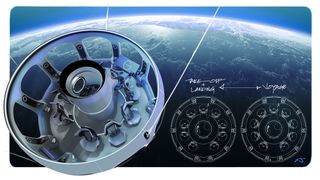
Stephenson, who had previously worked for high-end car makers including BMW, Ferrari, Maserati and McLaren, said the biggest challenge was keeping the capsule light enough so that it can be safely lifted by the balloon while still making sure every aspect of the interior lives up to the expectations of passengers.
“It's very easy to add weight to things and make it super comfortable," Stephenson said. "It's more difficult to reduce weight, reduce material and still make it feel like a very unique experience."
When fully inflated, the stratospheric balloon will be 460 feet (140 meters) tall, towering over the gleaming space capsule. The balloon is designed to detach from the capsule during descent. The capsule will then be brought down to a landing under a steerable parachute. Mira said the balloon technology is inherently safer than rockets loaded with explosive fuels. It also produces no greenhouse gas emissions, making the experience 100 percent compliant with the most stringent environmental protection standards.
— Space Perspective wants to take tourists on balloon rides to the stratosphere
— Space Perspective partners with Exclusive Resorts for balloon rides to the stratosphere
— Space Perspective starts selling seats for balloon rides
"We are using mature technologies," said Mira. "Balloons in general have been around for more than 200 years. This type of balloon, stratospheric balloons, have been around for almost 100 years. The first human went to the stratosphere on a balloon in 1931."
HALO Space plans to fly from spaceports in the Mojave Desert in the U.S., Spain, Australia and Saudi Arabia. The company is currently working with the U.S. Federal Aviation Administration to receive a license before its first crewed flight next year.
Join our Space Forums to keep talking space on the latest missions, night sky and more! And if you have a news tip, correction or comment, let us know at: [email protected].

Tereza is a London-based science and technology journalist, aspiring fiction writer and amateur gymnast. Originally from Prague, the Czech Republic, she spent the first seven years of her career working as a reporter, script-writer and presenter for various TV programmes of the Czech Public Service Television. She later took a career break to pursue further education and added a Master's in Science from the International Space University, France, to her Bachelor's in Journalism and Master's in Cultural Anthropology from Prague's Charles University. She worked as a reporter at the Engineering and Technology magazine, freelanced for a range of publications including Live Science, Space.com, Professional Engineering, Via Satellite and Space News and served as a maternity cover science editor at the European Space Agency.
Across the universe, dark matter annihilation could be warming up dead stars
Mysterious dark matter may leave clues in 'strings of pearls' trailing our galaxy
'Star Trek: Discovery' S05, E05 is a quality installment, but it's weighed down by another anchor of nostalgia
Most Popular
- 2 China launches 3 astronauts to Tiangong space station on Shenzhou 18 mission (video)
- 3 Across the universe, dark matter annihilation could be warming up dead stars
- 4 During the solar system's chaotic era, Jupiter may have helped form Earth's moon
- 5 Watch 2 cosmonauts conduct spacewalk outside the ISS today
An Overview of Space Tourism
- First Online: 23 March 2024
Cite this chapter

- Kang-Lin Peng 4 ,
- IokTeng Esther Kou 5 &
- Hong Chen 6
Part of the book series: Contributions to Management Science ((MANAGEMENT SC.))
33 Accesses
The expansion of travel boundaries has been a significant aspect of human history (Cohen, Tour Recreat Res 42:22–31, 2017). In recent times, the tourism industry has extended its reach to outer space (Bushnell DM (2021) Space tourism and commercial deep space: humans going to and beyond low earth orbit. In technological breakthroughs and future business opportunities in education, health, and outer space. IGI Global, pp. 281–290).
This is a preview of subscription content, log in via an institution to check access.
Author information
Authors and affiliations.
Faculty of International Tourism and Management, City University of Macau, Macau, China
Kang-Lin Peng
IokTeng Esther Kou
Institute for Research on Portuguese-speaking Countries (IROPC), City University of Macau, Macau, China
You can also search for this author in PubMed Google Scholar
Corresponding author
Correspondence to Kang-Lin Peng .
Rights and permissions
Reprints and permissions
Copyright information
© 2024 The Author(s), under exclusive license to Springer Nature Singapore Pte Ltd.
About this chapter
Peng, KL., Kou, I.E., Chen, H. (2024). An Overview of Space Tourism. In: Space Tourism Value Chain. Contributions to Management Science. Springer, Singapore. https://doi.org/10.1007/978-981-97-1606-7_1
Download citation
DOI : https://doi.org/10.1007/978-981-97-1606-7_1
Published : 23 March 2024
Publisher Name : Springer, Singapore
Print ISBN : 978-981-97-1605-0
Online ISBN : 978-981-97-1606-7
eBook Packages : Business and Management Business and Management (R0)
Share this chapter
Anyone you share the following link with will be able to read this content:
Sorry, a shareable link is not currently available for this article.
Provided by the Springer Nature SharedIt content-sharing initiative
- Publish with us
Policies and ethics
- Find a journal
- Track your research
Watch CBS News
Most distant spacecraft from Earth sends data to NASA for first time in 5 months
By Kerry Breen
Updated on: April 23, 2024 / 8:45 PM EDT / CBS News
The most distant spacecraft from Earth has resumed sending data after a five-month gap, NASA said Monday.
NASA's Voyager 1 spacecraft was launched in 1977, about two weeks after the launch of its twin, Voyager 2. The spacecraft has spent over 45 years studying the outer solar system and has made flybys of Jupiter and Saturn and traveled more than 46,000,000,000 miles .
In November 2023, the spacecraft stopped sending "readable science and engineering data," NASA said in a news release . Mission controllers were able to determine that Voyager 1 was still receiving commands from Earth and operating normally, but the science data could not be read and researchers did not know the status of the craft's onboard engineering systems.
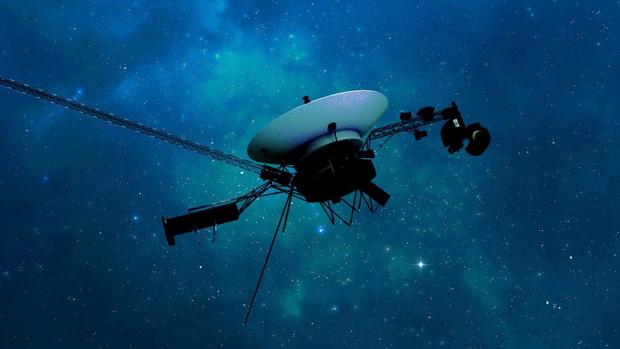
Last month, the craft's engineering team was able to confirm that the issue was related to one of the three onboard computers that make up Voyager 1's flight data subsystem. That system is what packages science and engineering data into a readable format before sending it to Earth. The team determined that "a single chip responsible for storing a portion of the (system's) memory," including some computer software code, wasn't working.
The chip couldn't be repaired and the code was too large to place in one new location, NASA said, so the team worked to relocate the affected code into multiple sections of the flight data subsystem. It took weeks to repackage the code, NASA said, and last Thursday, the new location was communicated to Voyager 1.
It takes about 22 and a half hours for a radio signal to reach Voyager 1 in interstellar space , or the space between stars, NASA said. On Saturday, the spacecraft's mission team received a response, confirming that the code modification had worked.
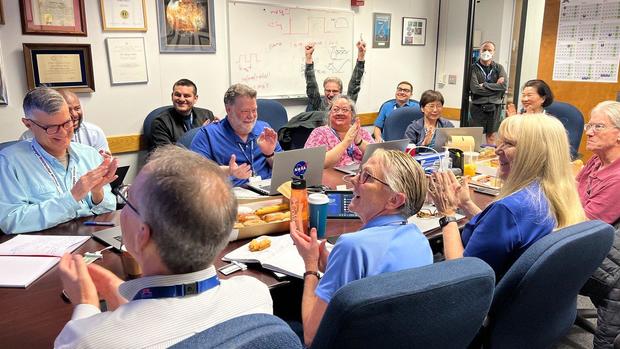
Engineers celebrated receiving new data for the first time in almost half a year, but the work isn't done yet. NASA said that in the coming weeks, the mission team will "relocate and adjust the other affected portions" of the software, including portions that will start returning science data. Meanwhile, Voyager 2 continues to operate with no issues, and both craft will continue to report back on the distant reaches of the solar system.
Kerry Breen is a reporter and news editor at CBSNews.com. A graduate of New York University's Arthur L. Carter School of Journalism, she previously worked at NBC News' TODAY Digital. She covers current events, breaking news and issues including substance use.
More from CBS News

Could some species dying on Earth be saved in outer space?

Scammers turn dating apps into "hunting grounds." Could companies do more?

Person fishing with magnet reels in "new evidence" in couple's killing

Meet "Toy Man," a humble humanitarian who's brought joy to thousands of kids

14:00-16:00
The increasing cost of solo travel in Ireland
Share this article
13.58 25 Apr 2024
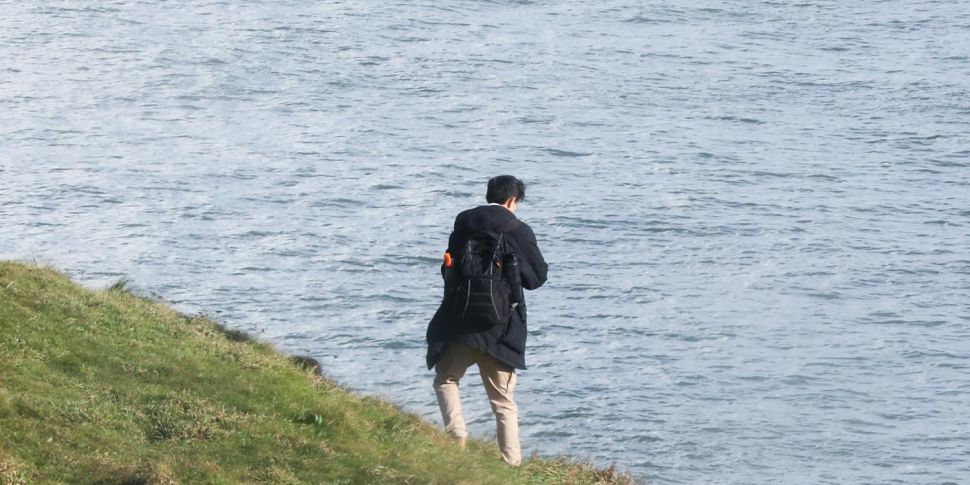
Listen to this episode

Subscribe to podcast
Despite Ireland seeing an increase in solo travellers year on year, the lack of single occupancy rooms is a massive problem, with hotels generally charging double room rates across the board.
Joining Seán to share her experience as a solo traveller is Travel Blogger Janet Newenham.
Read more about
Related Episodes

Why are celebrity baby names so weird?
Moncrieff Highlights

The Home Squad: Tiling
Lunchtime Live Highlights

Irish Astronaut is ready for space!
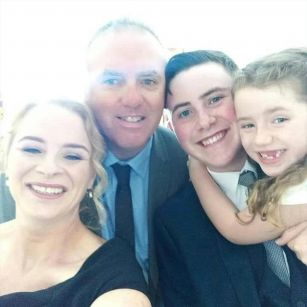
'I went from being a family of four to a family of one...'

Dáil suspended after comments on George Nkencho case

‘The city is dysfunctional’ - Does Dublin need a directly elected mayor?

Online misogyny driven by people making money 'hand over fist'
كم يدفع الأثرياء للسفر إلى الفضاء؟

دبي، الإمارات العربية المتحدة (CNN) -- أول إنسان جرّب ما يُعرف الآن باسم "تأثير النظرة العامة" كان رائد الفضاء السوفيتي يوري جاجارين، الذي أصبح أول شخص يرى كوكبنا من الفضاء منذ ما يزيد قليلاً عن 63 عامًا.
وعندما رأى حقيقة الأرض من الفضاء للمرة الأولى، صرخ قائلاً: "أنا أرى الأرض! إنها جميلة للغاية!". وقد كان الأول من بين العديد من رواد الفضاء الذين عبّروا عن شعورهم ب تحوّل إدراكي في الوعي حول مكان المرء في الكون، وهو شعور هائل بالرهبة.

وهناك ثلاثة أنواع من شركات السياحة الفضائية تتنافس الآن للسماح للأثرياء بعيش هذه التجربة.
في المقدمة، هناك شركة "سبيس إكس" التابعة للملياردير إيلون ماسك، وبالنسبة لأولئك الذين لديهم عشرات الملايين من الدولارات، يعد هذا المشروع برحلات صاروخية إلى المدار، واختبار انعدام الوزن على ارتفاع أكثر من 300 كيلومتر فوق الأرض.
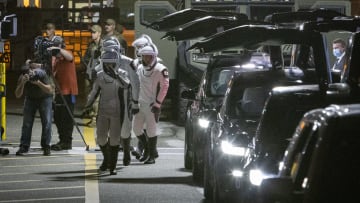
"تقودهم رائدة أمريكية".. انطلاق 4 رواد بمهمة Crew-7 بين "ناسا" و"سبيس إكس" إلى محطة الفضاء الدولية

هناك تجارب دون مدارية تقدّمها شركات مثل "Blue Origin" التابعة لجيف بيزوس و" فيرجن غالاكتيك" التابعة لريتشارد برانسون.
ويصل سعر هذه التجربة إلى 450 ألف دولار، وتأخذك لمسافة تتراوح بين 80 و120 كيلومترًا لتجربة انعدام الجاذبية.
ويُعد خط كارمان، الذي يقع على علو 100 كيلومتر فوق مستوى سطح البحر، الارتفاع المعترف به دوليًا باعتباره الحد الفاصل بين الغلاف الجوي للأرض والفضاء الخارجي
وتأمل شركات مثل "Space Perspective" و"World View" و"HALO Space" الإسبانية الناشئة، في نقل الركاب على متن رحلات منطاد بارتفاع يتراوح بين 25 و40 كيلومترًا فوق الأرض مقابل نطاق سعري يتراوح بين 50 ألف و200 ألف دولار.
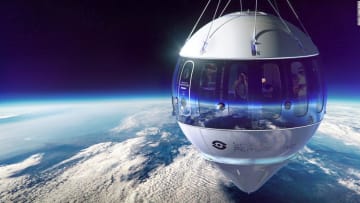
ألق نظرة على "سفينة الفضاء الوحيدة في العالم الخالية من الكربون"
الرحلات التجارية في عام 2026.

في الأسبوع الماضي بالعاصمة البريطانية لندن، كشف كارلوس ميرا، الرئيس التنفيذي لشركة "HALO Space"، عن التصميم الداخلي لكبسولته الفضائية "Aurora" التي يأمل فريقه أن تنقل 10 آلاف مسافر إلى الفضاء القريب بحلول عام 2030.
أما الكبسولة المضغوطة، التي صممها فرانك ستيفنسون، مصمم سيارات "فيراري" و"ألفا روميو" وغيرهما، يبلغ عرضها 5 أمتار وارتفاعها 3.5 مترًا، وسيتم تعليقها من منطاد هيليوم ضخم.
سيجلس 8 ركاب في الداخل لرحلات تصل مدتها إلى 6 ساعات.
وأعلنت "HALO Space" في العرض التقديمي أنها تقدّم "بدائل جديدة، وآمنة، وخالية من الانبعاثات للرحلات الفضائية"، وبعد أن أكملت بالفعل خمس رحلات تجريبية ناجحة، فإنها تُعد الشركة الأكثر تقدمًا في قطاعها.
تأسست الشركة في عام 2021، ولديها هدف طموح يتمثّل في البدء بتقديم رحلات تجارية في عام 2026، بدءًا من 164 ألف دولار أمريكي للفرد الواحد.
وأوضح ميرا أن فريقه كان قادراً على تحقيق التقدّم من خلال "استخدام التقنيات بالغة التطوّر".

مقابل 130 ألف دولار.. يمكنك تناول وجبة فاخرة على حافة الفضاء
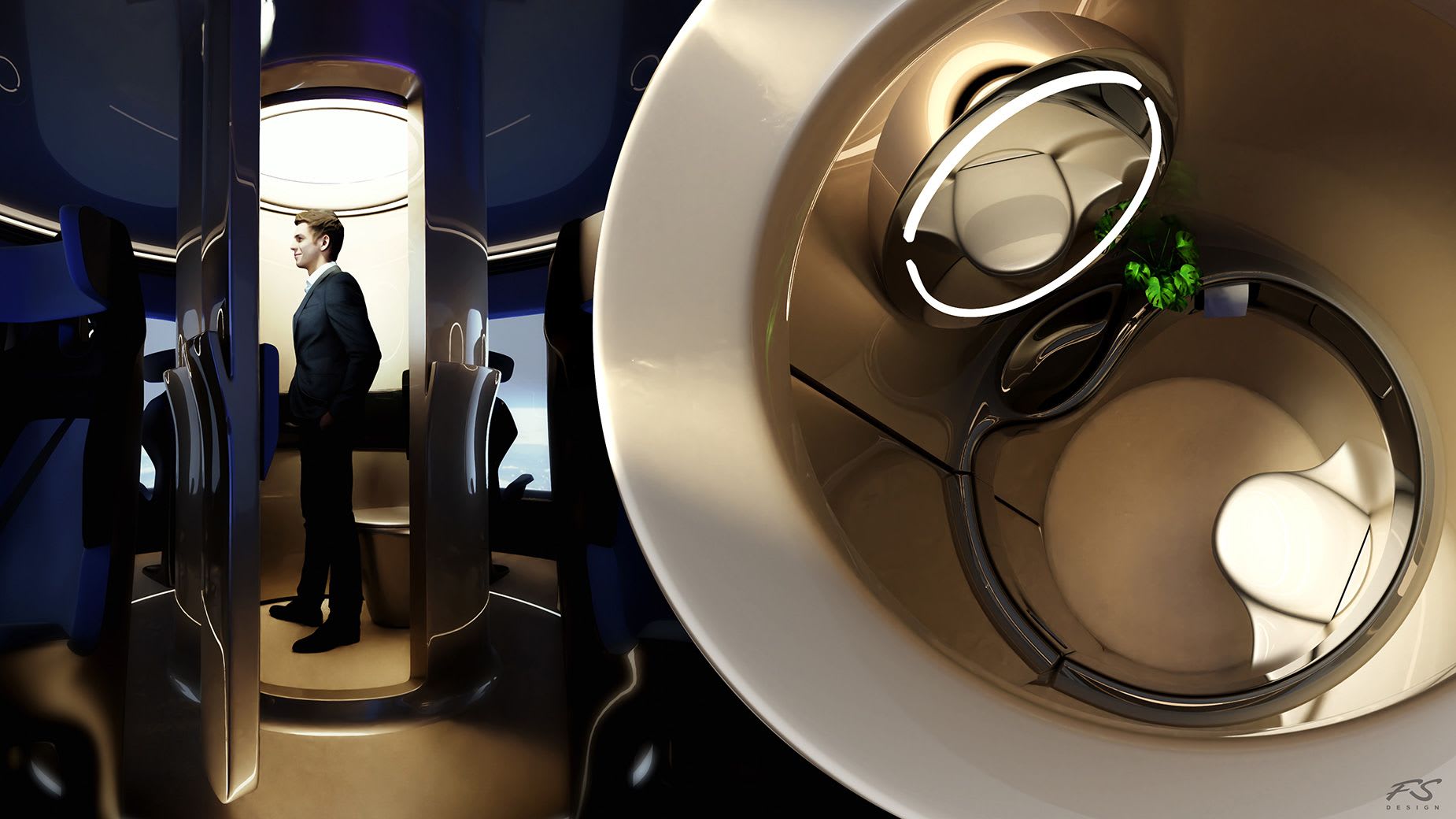
وأشار إلى أن النموذج التشغيلي لديهم لا يقوم على بناء كل شيء داخل الشركة، موضحا أن النهج الذي قاموا باتباعه يتمثل بـ "الشراكة مع أفضل اللاعبين بمجال الطيران في مختلف المجالات"،
وخلال تقديم ستيفنسون لتصميمه الحديث وخفيف الوزن، قال إنه "من السهل تصميم شكل داخلي جميل، ولكن من الصعب جعله يعمل".
وأضاف: "هناك أهداف وزن، وأهداف سلامة، وأهداف عوامل بشرية لتحقيقها، لكن هدفي كان إنشاء تصميم تشعر بالراحة فيه منذ البداية".
شروق شمس مميز

وضمن مساحة محدودة للغاية، كان لا بد من دمج مقاعد مريحة، ونوافذ عرض فسيحة، ومناطق تخزين، والأهم من ذلك، إضافة حجرة للحمام.
وتابع ستيفنسون: "عليك التأكد من أن الركاب يتم إعلامهم باستمرار، مع حصولهم على الترفيه، والاسترخاء"، بينما يجب أيضًا توفير القدرة لتناول الطعام، والشراب: والتواصل الاجتماعي.
وهذه إحدى مزايا تجربة انعدام الجاذبية، حيث يمكن للراكب التحرّك كالمعتاد من دون الحاجة إلى تدريب خاص.
وتقوم الشركة باختبار نموذج أولي للكبسولة بالحجم الحقيقي، وقد أُعلن عن الرحلة التجريبية التالية في شهر يونيو/ حزيران المقبل.
وأوضح ميرا أن "HALO Space" تخطط للعمل على مدار العام في أربع قارات، مع اختيار المواقع وفقًا لظروفها الجغرافية والطقسية الممتازة.
وكلما كان الجفاف والرياح أقل كلما كان ذلك أفضل، حيث أن الرياح القوية والسماء الملبدة بالغيوم تُعتبر أمرًا محظورًا عندما يتعلق الأمر بتقديم تجربة العمر للركاب.
وتنطلق الرحلات قبل الفجر، حتى يتمكن الضيوف من تجربة شروق الشمس "الأبيض" على حافة طبقة الستراتوسفير مع اللون الأسود العميق للفضاء خلفها.
تابعونا عبر
- سياسة الخصوصية
- شروط الخدمة
- ملفات تعريف الارتباط
- خيارات الإعلانات
- CNN الاقتصادية

IMAGES
COMMENTS
With new advancements in spaceflight technology, the costs of space travel are decreasing, making the dream of spaceflight a little closer for us all. Evolution of Spaceflight Costs and Technologies. During the space race, the cost of sending something into space averaged between $6,000 to over $25,000 per kg of weight not adjusted for ...
Space tourism industry could be worth $2.7 trillion by 2040 but many will travel for free says report. ... it's worth knowing that a ticket to reach space can cost as much as $55 million for a ...
For a trip on Virgin Galactic's SpaceShipTwo and Blue Origin's New Shepard, seats typically cost $250,000 to $500,000. "Those are suborbital transportation systems. They are about a 15-minute ride ...
Patrick Pluel/Getty; Alex Wong/Getty; Hollis Johnson/Insider. Virgin Galactic's $250,000 ticket to the edge of space includes a spacesuit. Passengers paying $55 million for SpaceX's mission to the ...
During the last 60 years, roughly 600 people have flown into space, and the vast majority of them have been government astronauts. For a suborbital trip on Virgin Galactic's SpaceShipTwo and Blue Origin's New Shepard, seats typically cost $250,000 to $500,000. Flights beyond that to actual orbit—a much higher altitude—are far more ...
How much does a ticket to space cost through Virgin Galactic? Originally, the company charged $250,000 to early buyers. And more than 600 people have already signed up at that price to be ...
Back in 2018, Reuters said that Bezos had planned to charge between $200,000 to $300,000 per ticket for a spaceflight. Meanwhile, Virgin Galactic said it's reopened ticket sales for flights a t ...
A seat on one of the company's spaceships originally cost $200,000. The company later raised the price to $250,000. It then stopped sales after a crash during a test flight in 2014. When the ...
Oct. 13, 2021. Blue Origin has declined to publicly state a price for a ticket to fly on New Shepard. The company is nearing $100 million in sales so far, Mr. Bezos has said. But it's unclear ...
They cost $450,000. On Tuesday, the aerospace company announced plans to sell tickets to the general public to snag a seat for a future spaceflight. Reservations open up Feb. 16 and will cost ...
The company has yet to disclose prices. NASA is developing its Space Launch System, which will carry astronauts to the moon and Mars. The rocket's per-launch cost has not been disclosed, but the ...
The reservation required a $500 deposit; the flight itself will cost $50,000 and last six to 12 hours. ... The market for space travel (and the sky-high prices that come with it), he believes ...
For now, though, costs remain enormous. A $450,000 ticket reserves a spot on Virgin Galactic's space plane, which flies 50 miles above Earth — six times a passenger plane's cruising altitude ...
As of right now (2021), the cost of booking a trip to space in the near future is approximately $250,000. The immediate cost of a trip to space (via something like SpaceX) in the next 2-3 years is in the tens of millions per passenger. In the medium-future, the cost of individual tickets into space will drastically fall in price.
The price tag is $200,000 per seat, including a $20,000 deposit. Tom Hanks, Paris Hilton, Katy Perry and Angelina Jolie are reported to have tickets as well. "We have a very diverse set of ...
For today's space companies, it's anyone willing — and wealthy enough — to pay the steep cost. NASA said it would cost $35,000 a night for stays on the ISS, and the price to get there is ...
13 Things Tourists Should Know Before Traveling to Space, According to Astronauts. We asked the pros for their best tips on handling a first trip to space.
In 2004, Branson vowed to offer tickets for $200,000; by 2019, reservations cost $250,000 per person. According to NBC, over 700 people have booked slots so far. Among them are Leonardo DiCaprio and Justin Bieber, who in 2013 tweeted "let's shoot a music video in SPACE!!" If budget space travel isn't your style, another option is Axiom Space ...
For now, the most significant barrier for space tourism is price. But air travel was also once expensive; a one-way ticket cost more than half the price of a new car. Most likely, the price for space travel will reduce overtime as well.
Book Your Reservation. Individual Space Explorer Seat Total Refundable Deposit: Starting from $1,000 USD per Explorer seat Total Cost: $125,000 USD per Explorer seat. Total. $1,000.
The total ticket price is $450,000 with an initial deposit of $150,000, largely refundable, except for a $25,000 Future Astronaut Community Access fee. The company's first Virgin Galactic space ...
Reminder to Space-A travelers: Keep in mind there is no guarantee you will be selected for a seat. Space-A travelers must be prepared to cover commercial travel expenses if flight schedules are changed or become unavailable to allow Space-A travel (Per DODI 4515.13, Section 4, Paragraph 4.1.a).
Space-A is being able to travel on DOD aircraft for free or at a limited cost. The flights you take are on a space-available basis, and the number of passengers they take will depend on the flight. Space-A can get you to many different places worldwide, but some locations are more challenging to fly to than others.
The Spanish-headquartered firm unveiled the design of the 3.9-ton (3.5 metric tonnes) Aurora capsule at an event in London on Wednesday, April 10, and said it hoped to begin commercial operations ...
The expansion of travel boundaries has been a significant aspect of human history (Cohen 2017).In recent times, the tourism industry has extended its reach to outer space (Bushnell 2021).This has been made possible by advancements in manned spaceflight technology and the commercialization of space (Teske and Adjekum 2021).As a result, individuals can now venture beyond the Kármán line and ...
The most distant spacecraft from Earth has resumed sending data after a five-month gap, NASA said Monday. NASA's Voyager 1 spacecraft was launched in 1977, about two weeks after the launch of its ...
But as the cost of living in the US increased, and the Los Angeles artist, in her 60s, struggled to find an affordable space where she could support other artists, she began thinking about a new ...
The increasing cost of solo travel in Ireland. Listen to this episode. Moncrieff. Subscribe to podcast. ... Irish Astronaut is ready for space! Lunchtime Live Highlights. 00:12:59. 00:15:32
Here are some of the top ways Americans may be able to reduce the overall cost of a trip, according to travel experts. 1. Be flexible with trip timing and location. Being flexible with your plans ...
تطمح شركة "HALO Space" الإسبانية الناشئة أن تبدأ رحلات تجارية إلى الفضاء القريب في عام 2026. وستستغرق الرحلات حوالي 6 ساعات. وتبدأ أسعار التذكرة للفرد من 164 ألف دولار.